
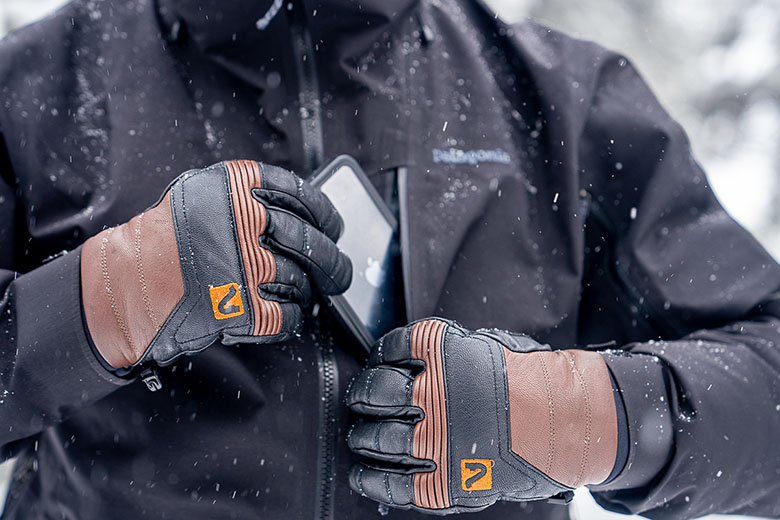
Nothing ruins a great day on the slopes like frozen fingers, and a quality glove or mitten can make all the difference. Choosing one that fits the conditions and type of skiing you do most is an important decision. The more you ride, the more you should think about making an investment that will keep your hands dry and toasty during wicked cold or wet and sloppy conditions. Options range from gauntlet-style synthetic gloves to undercuff leather designs from powerhouses such as Swedish manufacturer Hestra and backcountry mainstays Black Diamond and Outdoor Research. Below are our picks for the top ski gloves and mittens for the season, with price points from over $400 all the way down to $30 or less for the classic lift-op leather gloves. All designs on this list are either unisex or include a link to the women’s-specific version. For more background information, see our comparison table and buying advice below the picks.
Editor’s note: We updated this guide on September 3, 2024, to add new options from Hestra, Outdoor Research, and Ortovox. We also included details about our testing practices and scanned the round-up to ensure all information was up-to-date.
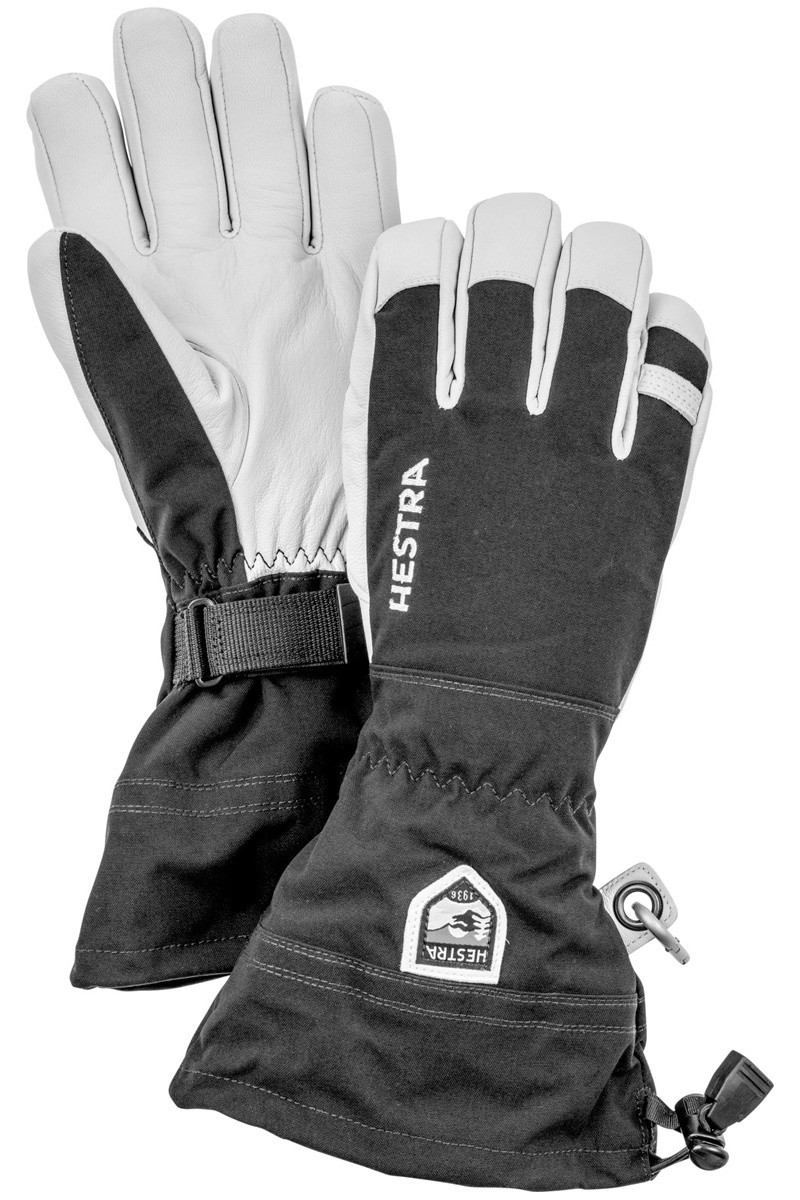 Cuff style: Gauntlet
Cuff style: Gauntlet
Shell: Polyamide/goat leather
Insulation: G-Loft synthetic & fleece
What we like: Beautifully made, cozy and warm, and good dexterity.
What we don’t: Requires some maintenance to stay waterproof.
Ski professionals the world over have trusted Swedish manufacturer Hestra for decades, and their Army Leather Heli glove is our top pick. This comfortable and highly functional ski glove has been around for years, and its hybrid leather and synthetic construction remains best in class. The Heli’s premium build quality, warmth, and comfort all stand out at a price that undercuts other high-end ski gloves. For these reasons, we think the Heli is the perfect partner for keeping you warm on the mountain, especially on deep powder days.
As with nearly all Hestra products, the Heli has liberal amounts of leather in its construction. The benefit is that the glove flexes easily and is very durable, but you will occasionally want to reapply a leather conditioner to the palm and fingers to keep moisture at bay (a small sample of Hestra’s Leather Balm is included with purchase). Some prefer a glove with a nylon shell for better waterproofing, but we find the simple maintenance and increased dexterity the leather provides are well worth the effort—even for skiing in the wet snow of Tahoe and the Pacific Northwest. This popular glove has spawned a couple variations, including a Heli mitten for maximum warmth and a 3-finger glove that splits the difference.
See the Men's Hestra Heli Glove See the Women's Hestra Heli Glove
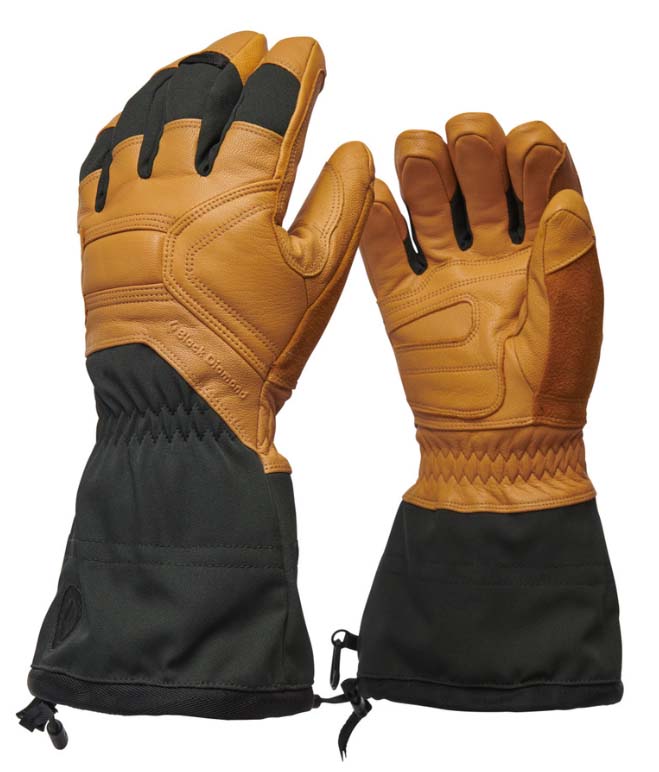 Cuff style: Gauntlet
Cuff style: Gauntlet
Shell: Nylon/leather
Insulation: PrimaLoft One (170g) & wool
What we like: Very warm, long-lasting build, and comfortable.
What we don’t: Takes some time to break in; below-average dexterity.
Black Diamond’s Guide glove is legendary among hardcore skiers for its impressive warmth and durability. It’s near the top in terms of hand protection on this list, and unlike the Hestra Heli above, the design is completely waterproof with a Gore-Tex insert. Inside its very tough exterior, Black Diamond uses both PrimaLoft synthetic and thick, boiled wool in the removable liner for insulation. If your hands are consistently cold or you ski regularly in frigid conditions, the Guide Glove is hard to beat.
The downside of all this material is that the BD Guide can take some time to break in. And even after many days of consistent use, ours still lacks the flexibility that you get right out of the box with the Hestra Heli, which is similarly warm (this is one downside of the Gore-Tex liner). It’s a compromise many are willing to make, however, and the Guide is among the most popular ski gloves on the market. If you run warm or only head out in mild conditions, you can save money by opting for a glove with lighter insulation and better dexterity, such as the Outdoor Research Arete II or Black Diamond Legend below.
Read more: Black Diamond Guide review
See the Black Diamond Guide Glove
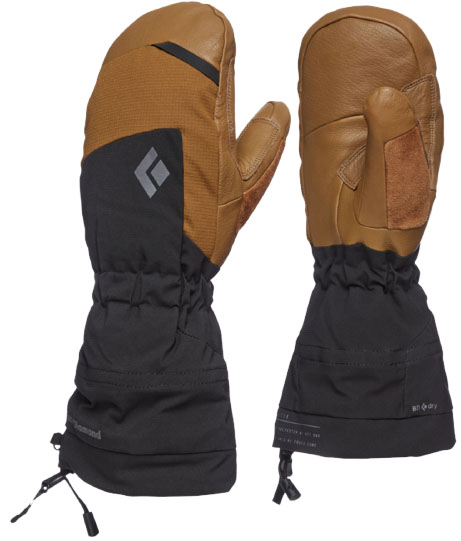 Cuff style: Gauntlet
Cuff style: Gauntlet
Shell: Nylon/leather
Insulation: PrimaLoft Gold (133 & 170g)
What we like: Warm, tough, and reasonably affordable.
What we don’t: Harder to grip a ski pole.
For keeping your hands as warm as possible, you just can’t beat a mitten design. It may compromise dexterity for skiers trying to grip a ski pole, but by keeping your fingers together, you get extremely efficient warmth thanks to your fingers warming each other. The Black Diamond Mercury is our favorite mitten option for offering the expected bump in warmth without a huge leap in price. It’s also made with a four-way stretch in the shell and includes removable split-finger liners to make it very user-friendly.
As with other BD ski gloves we’ve worn, the Mercury has a bomber construction that should hold up to plenty of wear and tear. Really, the only downside is whether or not you’re comfortable wearing a mitten. We still find gloves to be more convenient and effective for skiing—and the Mercury, in particular, is a bit bulky for handling a pole—but mittens are nevertheless a good option for those prone to getting cold hands. If you’re willing to compromise a bit of warmth for added dexterity, check out slightly sleeker designs like the Hestra Heli (above) and Swany X-Cell.
Read more: women's Black Diamond Mercury Mitt review
See the Black Diamond Mercury Mitt See the Women's BD Mercury Mitt
 Cuff style: Gauntlet
Cuff style: Gauntlet
Shell: Polyester
Insulation: Polyester
What we like: Standout comfort, warmth, and waterproofing at a great price.
What we don’t: Fake leather palm; liner isn’t removable.
If you only get out a handful of times each year or don’t want to blow your ski gear budget on gloves, the Gordini GTX Storm is a winner. You don’t get the premium shell fabric or leather palm of our top picks, but this glove is durable, features Gore-Tex waterproofing, and just plain works. In addition, warmth and coziness are surprisingly good considering the $75 price—it’s a step down from the Hestra Heli and Black Diamond Guide above, but the difference isn’t substantial, and this glove should be plenty for most days on the hill.
The GTX Storm is a solid option for wet conditions with its top-shelf Gore-Tex membrane. There are warmer options to be sure, but generally that will mean more bulk. Outdoor Research's Revolution II Glove is another great contender (the mitten version is featured below), but it’s hard to beat the quality, fit, and finish of the GTX Storm, which is one of the best budget ski gloves we’ve used to date. Its combination of comfort, dexterity, and protection make it a standout in the sub-$100 price range.
See the Men's Gordini GTX Storm See the Women's Gordini GTX Storm
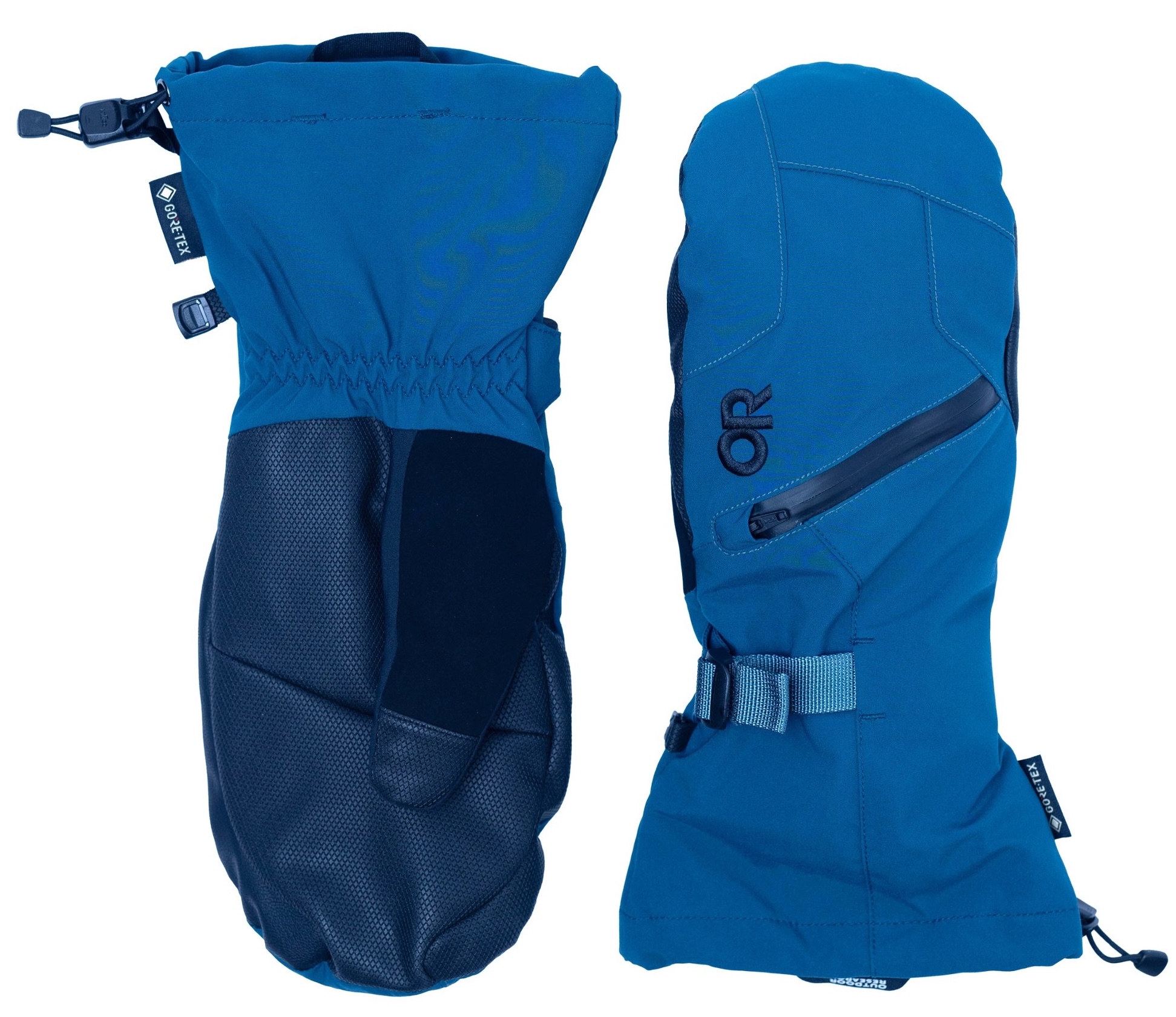 Cuff style: Gauntlet
Cuff style: Gauntlet
Shell: Polyester
Insulation: EnduraLoft (200g)
What we like: Warm, well made, and touchscreen- and handwarmer-compatible.
What we don’t: Harder to grip skis, a bit limited in ultra-cold conditions.
Sometimes simple and affordable gets the job done, and Outdoor Research's Revolution Gore-Tex Mitt is our favorite budget mitten of the year. With 200-gram synthetic insulation and a proven Gore-Tex insert, the Revolution is both warm and reliably protective. What's more, the combination of ladder-lock wrist cinch and drawcord-equipped gauntlet make it easy to batten down the hatches. As we touched on above, it's also sold in a glove version (called the Revolution II) that's an equally standout value at $89.
While the value is there, some of the quality refinements found in more expensive options are missing—namely a leather palm for better grip and feel—and other mittens have easier-to-use cinch cords. The Hestra Powder Gauntlet costs a bit more at $95, but it provides slightly better warmth, comes with a leather palm and removable liner, and is made by one of the best companies in the business. Still, for those who prefer to avoid leather or are set on Gore-Tex, the OR Revolution is an incredible deal.
See the OR Revolution Gore-Tex Mitten
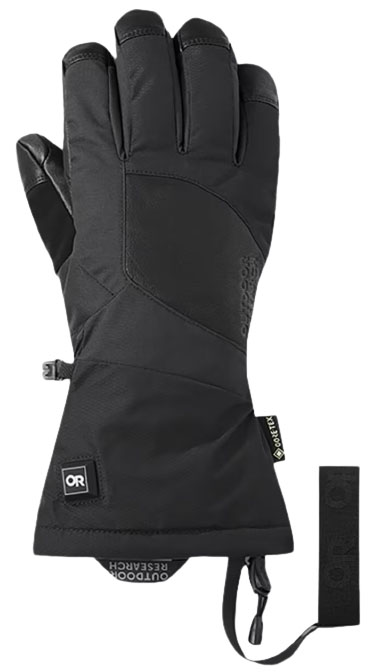 Cuff style: Gauntlet
Cuff style: Gauntlet
Shell: Nylon/leather
Insulation: EnduraLoft (133 & 333g) & AltiHeat system
What we like: Effective battery-powered heater for maximum warmth.
What we don’t: Expensive, high setting depletes battery, and not compatible with avalanche beacons.
For sub-zero conditions or for skiers who just can’t keep their hands warm, a heated glove may be the ticket. Year after year, Outdoor Research is known for having a strong lineup of heated handwear, and we like their Prevail Gloves best. The time-tested tech—including a built-in battery and heating element—give you a rush of heat that a hand warmer just can’t match. Pushing the button on the gauntlet switches between three heat settings (low, medium, and high), and the thick EnduraLoft insulation effectively traps the warmth inside. With its removable and rechargeable lithium-ion battery (extra sets are available for $50), keeping the gloves powered is simple.
There are two large impediments to a battery-powered design: price and avalanche beacon compatibility. We understand that there’s a lot of technology that goes into keeping the streamlined battery performing in frigid temperatures, but $339 is a lot for a pair of gloves. More concerning is the fact that the electronic components can interfere with beacons and impede location during a rescue, so these are gloves for the resort only. But if you need maximum warmth at all costs, the Prevail may be worth a try. For a step down, it’s also worth checking out OR’s more dexterous and affordable Sureshot Heated Softshell Gloves ($269).
See the Outdoor Research Prevail Heated GTX Glove
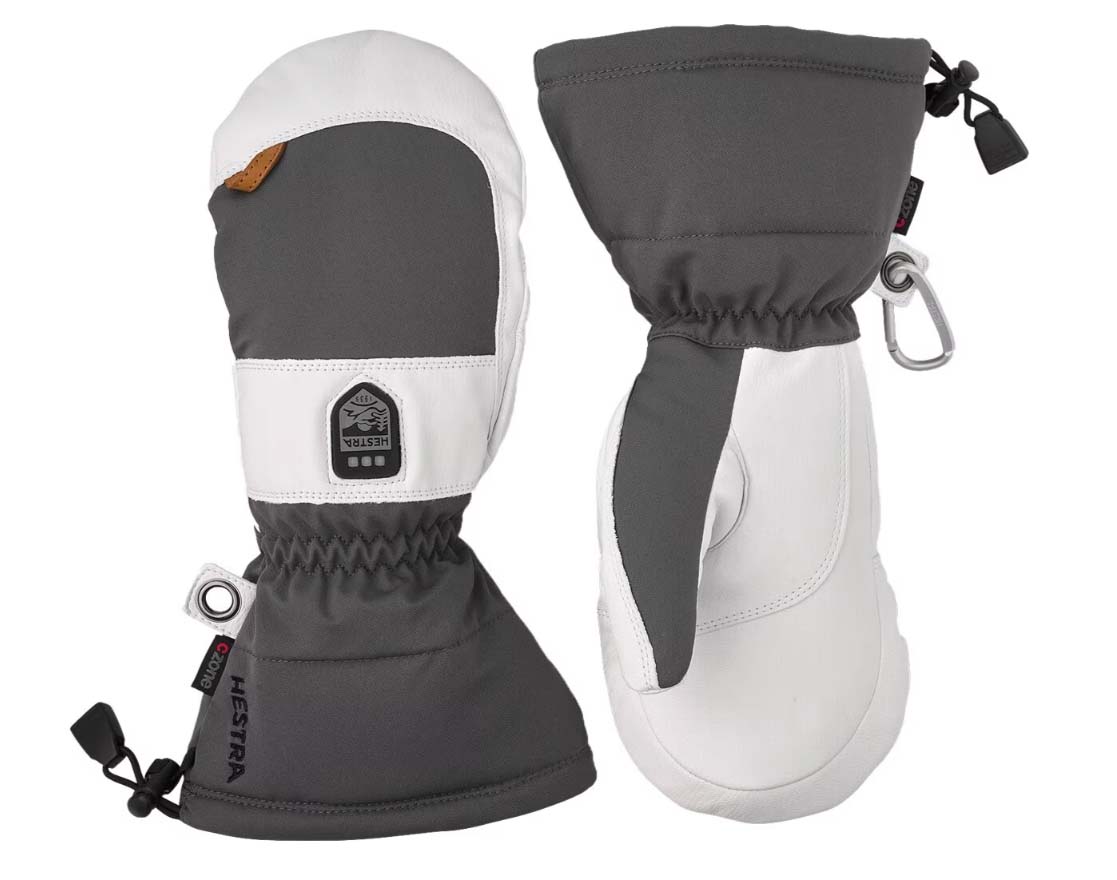 Cuff style: Gauntlet
Cuff style: Gauntlet
Shell: Softshell/goat leather
Insulation: G-Loft synthetic
What we like: A top-end mitten with extended, maximum warmth.
What we don’t: Very expensive, somewhat bulky, and should not be used with a beacon.
For ultra-wet cold days or for hands that don't last long in sub-zero conditions, sometimes you need to bring all the firepower you can muster. Enter the heated mitt. Great for folks with Raynaud's syndrome or those who regularly ski in the coldest places, a heated mitten can make a huge difference, with Hestra's top-of-the-line Power Heater leading the charge. The G-Loft insulation effectively traps warmth inside, and with the USB rechargeable battery, keeping the mittens powered is easy. Heat lasts for 8 to 10 hours on low, 4 to 5 hours on medium, and about 2 hours on high.
As we touched on above with the OR Prevail, the largest hurdle to a battery-powered design is price—$425 for a pair of mittens is simply hard to justify for all but the most committed—and coldest—of skiers. But if you find yourself stopping regularly because your fingers are too cold, the high cost may very well be worth it. That said, keep in mind that the electronic components of heated gloves can interfere with avalanche beacons, so the Power Heater should be used exclusively inbounds at a resort. Lastly, for some steep savings over the Hestra, it's worth checking out Eddie Bauer's more affordable First Ascent Guide Pro Smart Heated Mittens for $299.
See the Hestra Power Heater Gauntlet Mitt
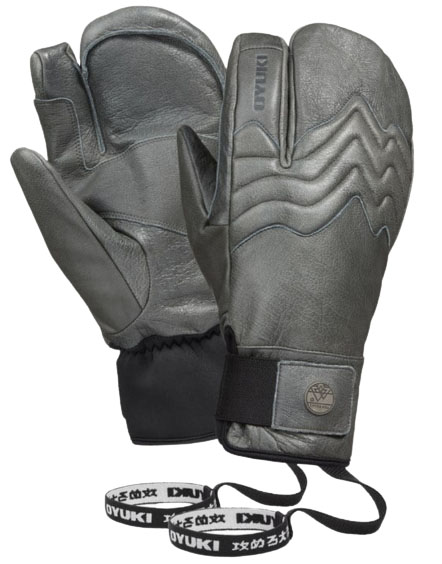 Cuff style: Undercuff
Cuff style: Undercuff
Shell: Leather
Insulation: PrimaLoft Gold (133 & 200g)
What we like: Premium build at a reasonable price.
What we don’t: Split-finger design still can’t match the warmth of a mitten.
If you’re on the fence between a glove and a mitten, it’s worth looking into a trigger mitt (also known as a three-finger mitt or lobster mitt). On paper, this concept is the best of both worlds: Combining a mitten with a dedicated slot for your pointer finger, you get more thermal efficiency than a standard glove, while retaining enough dexterity to pinch a zipper, fiddle with your bindings, or even send a text. The downsides are that your pointer finger ends up being just as cold as it would be in a glove, and freedom of movement still falls short of a regular five-finger design. But trigger mitts nevertheless provide a nice middle ground of warmth and dexterity, and we think Oyuki’s Pep pulls it off better than most.
We snagged a pair of the Pep Trigger Mitts a couple winters back—our tester's first experience with the three-finger design—and were immediate converts. Built out of premium goatskin leather, the Oyuki only gets better with age, and the undercuff design is sleek yet secure with a wide hook-and-loop cinch. There’s a lot going on under the hood, too: The Pep comes with high-quality touches like a Gore-Tex waterproof insert, warm PrimaLoft insulation (200g on the back of the hand and 133g on the palm), and a soft fleece lining. And Oyuki nailed the styling with a simplistic aesthetic and fun mountainscape sewn into the padded back of the hand. If you’re curious about the trigger design, the Pep (and women's Chika) is a solid option. Another excellent but slightly less warm design is Hestra's waterproof Freeride CZone 3-finger below.
See the Oyuki Pep Trigger Mitt See the Women's Chika Trigger Mitt
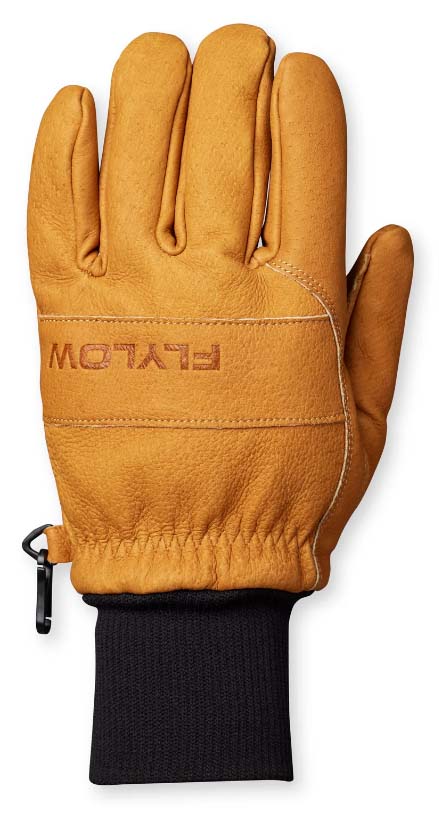 Cuff style: Undercuff
Cuff style: Undercuff
Shell: Leather
Insulation: Greenloft (100g & 180g)
What we like: Durable yet supple, affordable, and leather is pre-treated for waterproofing.
What we don’t: Not as warm as most gloves here; not great for areas with consistently wet snow.
Blame it on the lifties—leather work gloves have gained popularity in the ski world thanks to their durable and low-cost design. Among the options, which include hardware-store specials like the Kinco below, we like Flylow's Ridge Glove best. Like many modern leather designs, the Ridge features a supple pigskin leather shell and soft polyester lining, with synthetic Greenloft fill placed in between (100g at the palm and 180g at the back of the hand). But unlike most leather work gloves, the Ridge comes pre-treated with a durable water-repellent finish, so you won’t have to apply your own aftermarket wax (not right away, at least). Considering that Sno-Seal or a Nikwax alternative will run you around $10—and tack on a few hours of labor—the Ridge’s $55 price tag is a steal of a deal.
The Flylow Ridge are great resort and backcountry gloves for anyone on a budget, excellent for spring or fair weather, and they’re quite durable and breathable, all things considered. As for downsides, they're not the warmest available, and the lack of a waterproof membrane can be a problem in areas known for consistently wet snow (you’ll want to make sure to refresh the coating if you notice the gloves starting to absorb moisture). But these are minor complaints considering the price, and we especially appreciate how supple the Ridge is out of the box—far from the very stiff initial feel of the various Kincos. A final note: Flylow’s sizing runs small, so you’ll want to try the glove on if possible and consider sizing up.
See the Flylow Ridge Glove
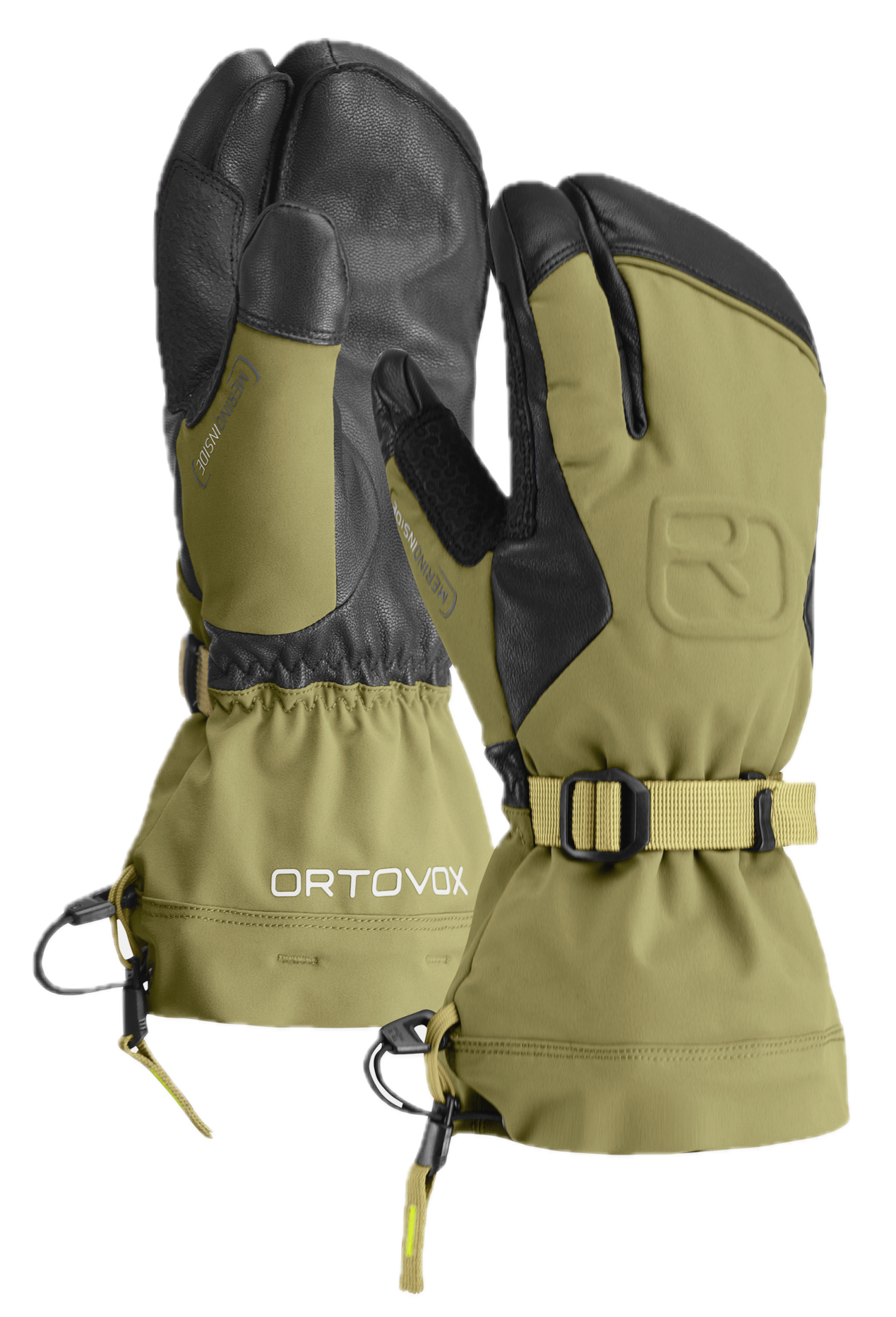 Cuff style: Gauntlet
Cuff style: Gauntlet
Shell: Leather
Insulation: Merino wool & polyester
What we like: An expertly built and sustainably minded design.
What we don’t: Most will want more insulation in bitterly cold temps.
Germany-based Ortovox is a leader in merino wool products, and their Merino Freeride 3 Finger Glove is a testament to their expertise. The shell is made entirely from premium goatskin leather, while the padding comprises merino wool scrap cuttings that would have otherwise gone to the landfill. What's more, the Sympatex membrane is both reliably water- and windproof, and we appreciate that it's made without harmful chemicals and certified as climate-neutral. Finally, while subtle, the insert between the thumb and index finger does a great job maximizing grip even when wet. Added up, it's clear that Ortovox put a lot of thought into the Freeride's design.
In practice, we've found the gauntlet-style cuffs very easy to adjust, and dexterity has been better than expected thanks to the narrower diameter of the thumb and pointer compared to other three-finger designs—great for tasks like adjusting buckles, removing climbing skins, and operating zippers. That said, the Freeride is far from the warmest option here, and we'd advise stepping up to a more insulated design in truly frigid weather. But overall build quality is excellent, and the $160 price tag is reasonable for what you get. Ortovox also makes the Freeride 3 Finger Pro, which comes with two separate liners for customizing warmth.
See the Ortovox Merino Freeride 3 Finger Glove
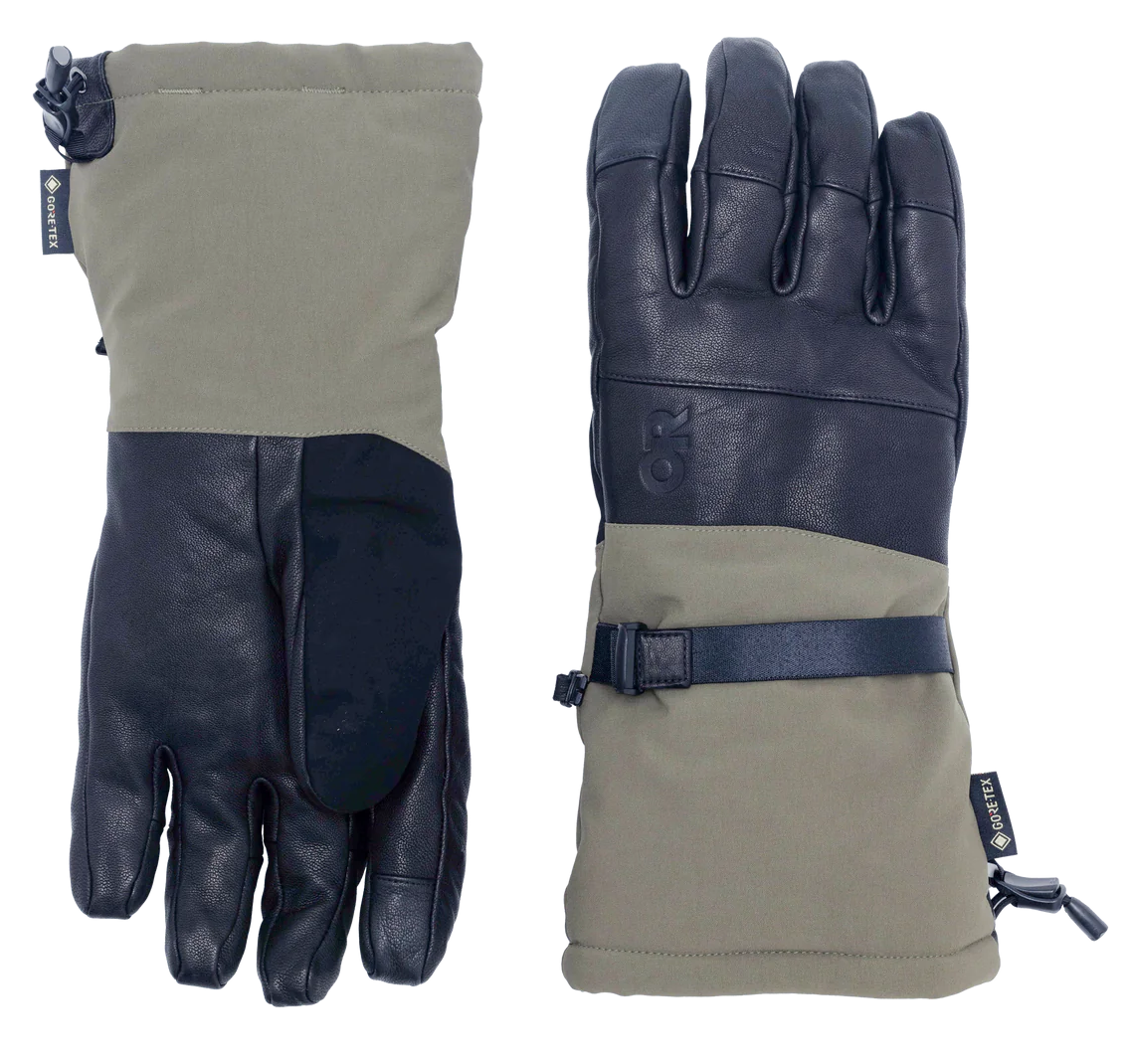 Cuff style: Gauntlet
Cuff style: Gauntlet
Shell: Nylon/leather
Insulation: VerticalX Eco (130 & 200g)
What we like: Desirable mix of price, toughness, and warmth.
What we don’t: Fairly bulky, which impacts dexterity.
Notwithstanding the $339 Prevail Mittens above, Outdoor Research consistently hits a really desirable mix of price and performance. We’ve had a number of their gloves on this list over the years—including the Arete below—and our current favorite from their resort line is the Carbide. For $130, this glove packs in a whole lot: a supple goat leather palm, a burly yet stretchy shell, and a healthy dose of warmth. The interior is soft and impressively cozy, and it has a secure feel in general with the large gauntlet closure and tightener at the wrist. It’s true the Carbide doesn’t have a removable liner—the aforementioned Arete does have this feature—but otherwise, it checks a lot of boxes for most skiers.
One area where the Carbide comes up a bit short is bulk. This isn’t a low-profile design by any means, and dexterity does suffer as a result. You may find yourself needing to slide them off more often than some of the pricier options like Swany's X-Cell below, and it does make it a little harder to use the touchscreen-friendly fingers. Additionally, we’ve found our Outdoor Research gloves don’t have particularly long lifespans, although there aren’t any notable areas of concern with the Carbide specifically. In fact, its tough bulk is a hallmark of the glove and one of many reasons we have it ranked as highly as we do.
See the Men's Outdoor Research Carbide See the Women's Outdoor Research Carbide
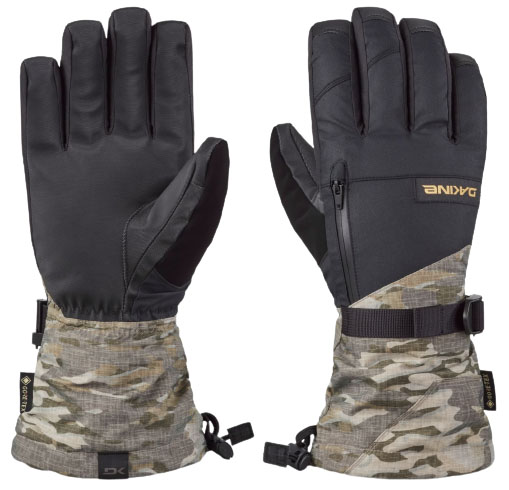 Cuff style: Gauntlet
Cuff style: Gauntlet
Shell: Polyester
Insulation: High-loft (110 & 230g)
What we like: Warm, fully featured, and great price.
What we don’t: Not as tough or dexterous as the Gordini above.
Year after year, Dakine’s Titan and women’s-specific Sequoia are top sellers among the resort crowd. The logic is simple: They offer no-nonsense warmth, the right combination of features for season-long use, and a great price point. With substantial synthetic fill in the shell and a surprisingly thick removable liner, the Titan's are about as insulated as gloves get in the sub-$100 price range. And Dakine nailed the details with an easy-to-adjust gauntlet closure, zippered pocket on the back of the hand for adding a heat pack, and touchscreen compatibility on the liner.
What’s not to like about the Dakine Titan and Sequoia? They’re priced similarly to the Gordini Storm above and deliver comparable warmth, yet fall a bit short in terms of material quality and dexterity. Their polyester shell is a little more prone to absorbing moisture than Gordini’s burly fabric, and we prefer the grippier palm on the Storm. In addition, the Titan and Sequoia’s thick liner makes it difficult to hold onto small items like a zipper, although it’s still easy to maintain a solid grip on a ski pole. For a step up in quality, check out the leather Dakine Excursion ($130), which forgoes the removable liner but features a 360-gram wool lining and PrimaLoft insulation.
See the Men's Dakine Titan GTX See the Women's Dakine Sequoia GTX
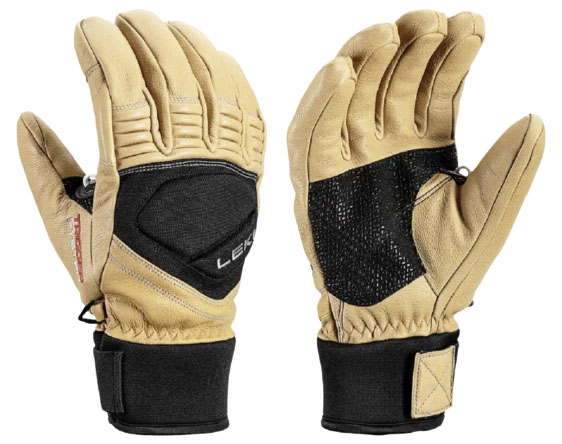 Cuff style: Undercuff
Cuff style: Undercuff
Shell: Leather/neoprene
Insulation: Fiberloft synthetic
What we like: Sleek Trigger system allows strap-free pairing with compatible Leki poles.
What we don’t: Not enough glove for particularly cold climates.
Leki is best known for their ski and trekking poles, but the German company also offers a full lineup of gloves for a range of outdoor uses. What sets their gloves apart is the built-in Trigger system—a durable fabric loop between the thumb and forefinger that attaches to a click-in-click-out hook on compatible Leki poles. This added tech not only removes the extra bulk and hassle of a strap but also offers a boost in safety with a 220-degree release angle that detaches the pole from the glove in the event of a snag or fall. In practice, we’ve found the Trigger System to be very slick: It's easy to locate the loop, and clicking in and out quickly becomes second nature.
The Copper S is one of our favorite Leki gloves, and there’s more to love than just the Trigger system compatibility. Specifically, you get a thin layer of Fiberloft insulation, stretchy Velcro cuffs that cinch close to the wrist to keep out drafts and snow, knuckle pads, and a neoprene patch for back-of-hand protection. It all adds up to a near-ideal mix of reliability, warmth, and dexterity for mild conditions or skiers who like a secure grip on their poles. If you run cold or ski in particularly frigid climates, it might be worth bumping up to the Leki Xplore S, which features high-loft PrimaLoft insulation and a generous gauntlet cuff. Regardless of which option you choose, the fabric loop is very low-profile and shouldn’t keep you from considering Leki gloves for use with non-Leki ski poles.
See the Leki Copper S
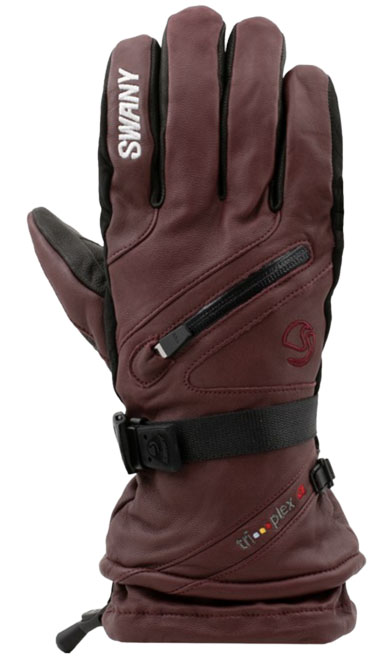 Cuff style: Gauntlet
Cuff style: Gauntlet
Shell: Leather
Insulation: PrimaLoft Gold synthetic
What we like: The right mix of features for resort use.
What we don’t: Not as beautifully made or warm as the Hestra Heli.
Swany’s X-Cell is not a new glove by any stretch, but its classic design has been lauded over the years for its resort skiing prowess. Made with tough leather covering the back of the hand and a reinforced palm, the dexterous Swany makes it easy to grip a zipper pull on a jacket or keep hold of your ski poles at full tilt. The gauntlet on the X-Cell isn’t as simple to operate as the Black Diamond Guide above, but it’s functional and does a fine job sealing out snow and cold gusts of wind.
What pushes the Swany X-Cell down our list? For its $180 MSRP, we give the edge for warmth to the Hestra Heli and BD Guide above, plus the X-Cell’s fixed liner is less adaptable and slower to dry than a removable design. The Swany will certainly do the trick for most ski days, but it’s been around long enough that the price should be dropped to remain competitive. If you can find it on sale, however, the X-Cell is a fully featured glove for downhill fun.
See the Men's Swany X-Cell Glove See the Women's Swany X-Cell Glove
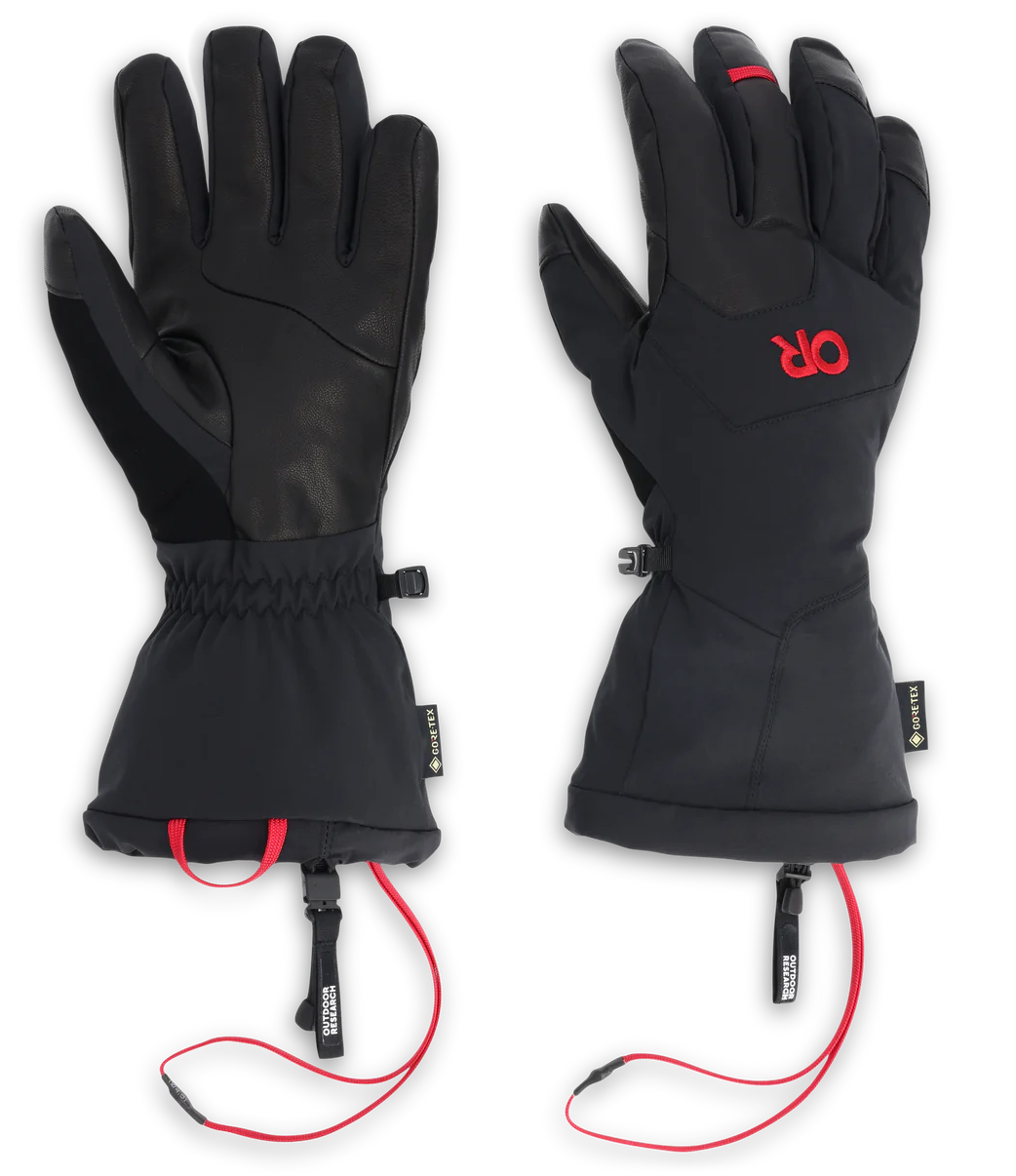 Cuff style: Gauntlet
Cuff style: Gauntlet
Shell: Nylon
Insulation: EnduraLoft (100g) & merino wool
What we like: A high-quality 3-in-1 design from Outdoor Research.
What we don’t: Lacks the warmth and dexterity of the Carbide above.
The snow in the Pacific Northwest can be wet and heavy, so it’s no surprise that we often turn to Seattle-based Outdoor Research for burly and waterproof ski gloves. Their popular Arete II is a great choice in the $100 price range with a durable nylon shell, proven Gore-Tex insert, 100-gram EnduraLoft insulation, and generous leather palm. It also features a removable merino wool liner, which adds a considerable amount of warmth and is so cozy that we often pair it with other gloves and mittens (depending on conditions). And with a pull tab on the inside cuff, the Arete is easier to get on than most.
How does the Arete II compare to OR’s own Carbide Sensor above? For about $20 more, the Carbide boasts considerably more insulation (130g at the palm and 200g at the back of hand) and has a sleeker design that forgoes a liner and adds a touchscreen-compatible index finger (despite the gloves’ bulk, it actually works most of the time). The linerless construction feels overall more supple, dextrous, and easy to wear, but it does lack the 3-in-1 versatility of the Arete. In the end, we still give the slight edge to the Carbide, but the Arete II isn’t far behind and stands out as another good value from OR.
See the Men's OR Arete II GTX See the Women's OR Arete II GTX
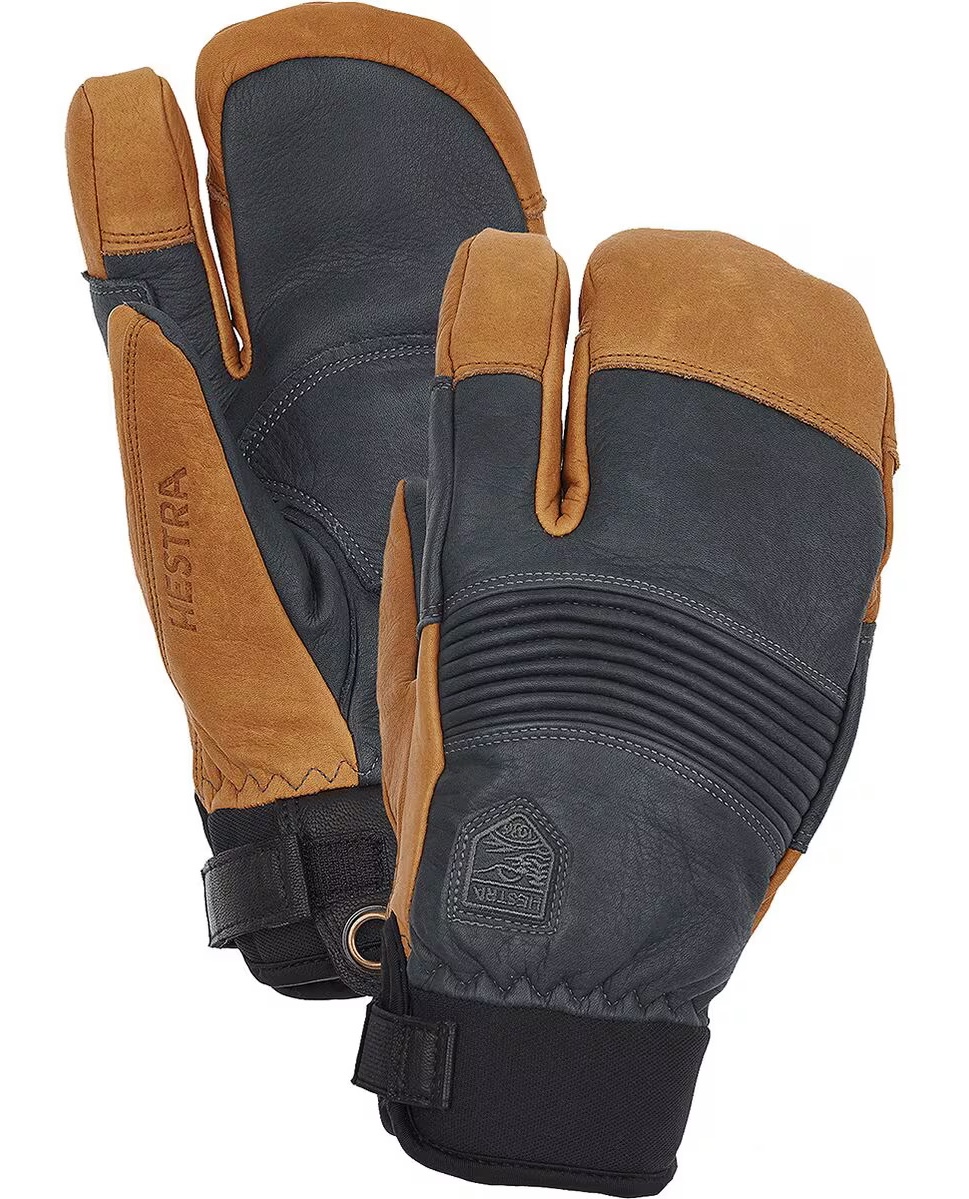 Cuff style: Undercuff
Cuff style: Undercuff
Shell: Leather
Insulation: Foam & synthetic
What we like: Work glove feel and fantastic look.
What we don’t: Not as warm as other options.
You won’t find a more beautiful ski glove than the Hestra Freeride CZone 3-Finger. This all-leather, undercuff design with exposed stitching is a work of art. It’s a great tribute to Hestra’s long history of glove making, and in addition to skiing, the Freeride CZone 3-Finger is one of our favorite options for everyday wear and work in the winter. It’s true that the Freeride isn’t for everyone as warmth falls short of the Oyuki Pep above (it’s best for mild days or those working up some heat), but you won’t find a better-made mitt. Period. If waterproofing isn't a must-have for you, Hestra's iconic Fall Line 3-Finger is largely similar but less versatile.
One small design oversight we’ve noticed is that when we cinch the cuff, there is a fair amount of excess strap hanging off the end. This will likely only be an issue for those with small wrists, although the loose strap did occasionally catch on our jacket sleeve and was a minor annoyance. But that did little to dampen our enthusiasm for the Freeride. Added up, the Hestra deftly balances comfort, dexterity, and a premium look and feel, making it one of our favorite high-end gloves for stormy days at the resort.
See the Hestra Freeride CZone 3-Finger
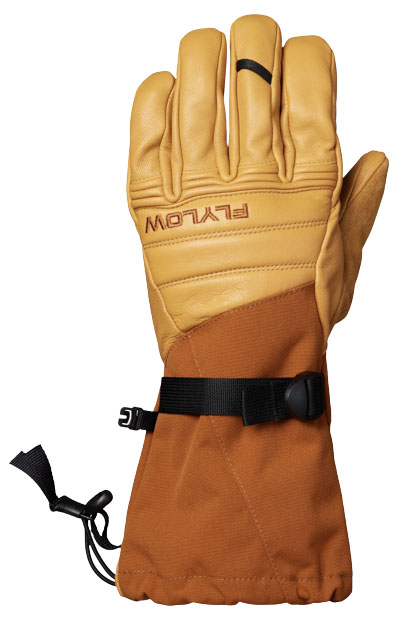 Cuff style: Gauntlet
Cuff style: Gauntlet
Shell: Nylon/leather
Insulation: Greenloft (120 & 280g)
What we like: Great price for a warm and dexterous glove.
What we don’t: Cheaper build quality and not a standout in waterproofing.
Flylow built their reputation in the glove world around simple leather designs that came pre-coated (and baked) with Sno-Seal, but they’ve stepped up their game with the Super D line. Offered in glove, mitten, and lobster styles, the Super D is substantially warmer and more protective than the brand’s Ridge Glove above, with 280-gram Greenloft synthetic insulation along the back of the hand and a wool blend lining throughout. Lighter 120-gram Greenloft around the front and flexible pigskin leather combine to offer outstanding dexterity. Tack on a waterproof membrane and 3 millimeters of foam on the back of the hand, and you have yourself a warm, waterproof, and stylish ski glove for a very reasonable $125.
Compromises are inevitable in keeping costs down, and some of the details on the Super D fall short of our top-rated designs. In particular, the plastic ladder buckle and webbing that cinch around the wrist have a cheap feel and can loosen during the day (it’s an easy fix to re-tighten them, however). And you miss out on a proven Gore-Tex liner for trusty, long-term performance in wet conditions. If you want a best-in-class design, we think BD’s premium Guide Glove above is a better option. But the Flylow is still quite cozy, resists moisture in all but the wettest conditions, and saves you a pretty substantial $55.
See the Flylow Super D Glove
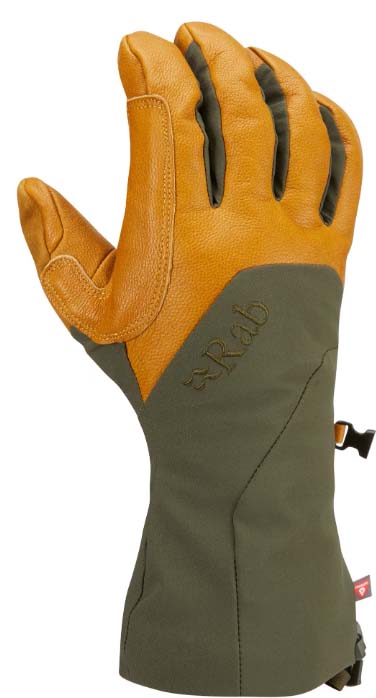 Cuff style: Gauntlet
Cuff style: Gauntlet
Shell: Nylon/leather
Insulation: PrimaLoft Gold (100 & 133g)
What we like: Supple leather requires no break-in period.
What we don’t: Pricey and not our favorite gauntlet and cuff design.
Rab’s Khroma collection is a great one-stop shop for high-end Gore-Tex ski apparel, and the Freeride is its latest glove offering. Put simply, the Khroma Freeride GTX is fully first-class with a waterproof Gore-Tex membrane, supple leather that requires no break-in period, an excellent pre-formed finger grip, and a flexible and premium feel that’s reminiscent of Hestras. Stretchy nylon along the back of the hand contributes to comfort and waterproofness, and we can’t get enough of the super-soft, high-loft pile interior. Rab is a relative newcomer to the U.S. market, but with high-quality designs, materials, and durable construction, the Khroma should not be overlooked.
That said, after our initial testing, we had a few minor gripes with the Khroma Freeride’s design. For one, the gauntlet opening is on the narrow side, which means it can take a few extra seconds to slide the glove over a ski jacket cuff (we don’t have this issue with the Hestra Heli or Black Diamond Guide). Second, the fit is fairly loose at the wrist, and the Freeride lacks a cinch here to help seal. Finally, while the generous insulation goes a long way toward keeping our fingers warm (even in single-digit temperatures), it does translate to a bit of compromised dexterity. In the end, we’re inclined to stick with gloves like the Hestra Heli, but for cold resort days, the Khroma Freeride GTX is another premium option to have on your radar (for $10 less than the Guides).
See the Rab Khroma Freeride GTX Glove
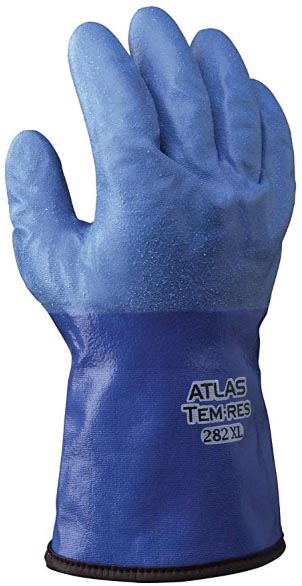 Cuff style: Undercuff
Cuff style: Undercuff
Shell: Polyurethane
Insulation: Acrylic
What we like: A waterproof and breathable backcountry-ready glove for under $30.
What we don’t: Odd looks and non-adjustable cuff.
Choosing the right full-on conditions ski glove can be a tricky process, but one model that’s starting to separate itself from the pack is Showa’s Temres 282. Don’t let the odd name and sub-$30 price tag fool you: This is a seriously capable glove. It’s extremely waterproof, yet surprisingly breathable, has a soft-touch fleecy liner, and is just warm enough to keep you comfortable on the downhill. Plus, the Temres is quite versatile, and its excellent dexterity and grippy build have made it a popular choice for everything from ice climbing to shoveling out the driveway.
If you want a waterproof design for touring, the Temres 282 is pretty hard to beat, although don’t expect to see too many of these blue gloves at your local resort. Most notably, the acrylic insulation isn’t intended for low-output use and sub-freezing days—it’ll run quite cold when you’re sitting on a slow-moving chairlift—and the open cuff at the end can’t be sealed or adjusted (note: Showa’s newer 282-02 model adds a wrist cinch). Durability-wise, we’ve found the thin blue shell to be rather resistant to abrasion, although our palm did tear on a particularly sticky pair of skins. And a final insight on fit: The Temres is known to run small, so it’s best to go up one size.
See the Showa Temres 282 Glove
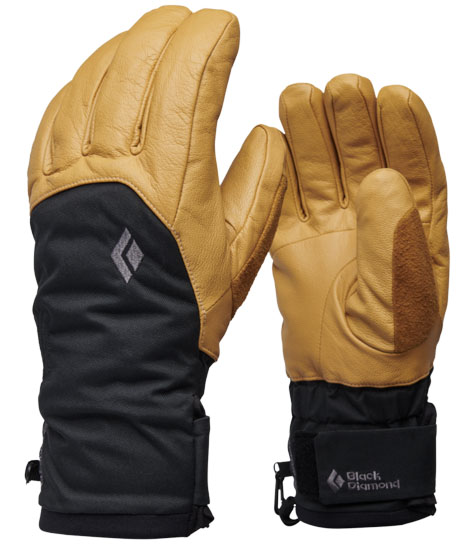 Cuff style: Undercuff
Cuff style: Undercuff
Shell: Nylon/leather
Insulation: PrimaLoft Gold (60 & 170g)
What we like: Functional leather and Pertex build with great dexterity.
What we don’t: Leather absorbs moisture and becomes cold.
Black Diamond's Legend appeals to the touring crowd with a low-profile, insulated, waterproof, and primarily leather design that fits under the cuffs of a ski jacket. The glove nicely balances protection and weight with high-quality PrimaLoft Gold synthetic fill and a water-resistant Pertex shell along the back of the hand. Finally, fit and finish is a step up from our previous Legend gloves, which were overly stiff and fell short of the premium Hestras above.
Despite the panel of nylon along the back of the hand and a Gore-Tex liner, we've found the Legend's do not excel in wet snow. Through a season of backcountry and resort skiing in British Columbia and Washington State, the leather sections of the glove have wetted out on a number of occasions and become noticeably cold (they do much better on dry snow days). On the plus side, the Legend has a great closure system, which stretches and is easy to secure, and the latest version features a neoprene cuff for an excellent seal at the wrist.
See the Men's Black Diamond Legend See the Women's Black Diamond Legend
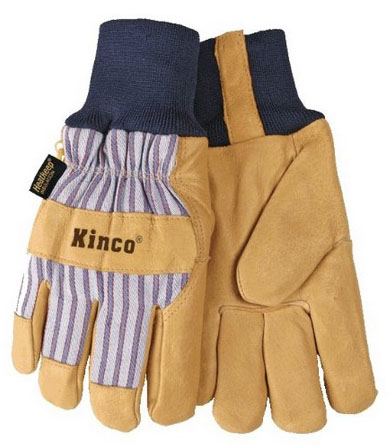 Cuff style: Undercuff
Cuff style: Undercuff
Shell: Canvas/leather
Insulation: HeatKeep synthetic
What we like: Trusted performance, ultra-low price.
What we don’t: Limited warmth (think hand warmers or liner gloves)
Kinco started the leather ski glove craze in the 1980s, and it wouldn't be a proper list without including them here. To follow in a long line of ski bums and resort employees, simply plunk down the $29 or so bucks these gloves generally sell for, buy some Sno-Seal to condition the leather and make it more water-resistant (finish the job with a hair dryer if possible), and ski to your heart's content.
You won't find a more economical glove option than the Kincos, and this system works surprisingly well if the conditions aren't too cold or wet. It's best to step up to a more waterproof design in the wet snow of the Pacific Northwest, but these gloves are a great match for areas with dry snow like Colorado and Utah. Don't forget to grab a PBR at the lodge to complete your get-up, and per tradition, retire them at the end of the season and repeat.
See the Kinco Pigskin Leather Glove
| Glove | Price | Style | Shell | Insulation | Liner |
|---|---|---|---|---|---|
| Hestra Army Leather Heli Glove | $160 | Gauntlet | Polyamide/leather | G-Loft synthetic & fleece | Yes |
| Black Diamond Guide Glove | $180 | Gauntlet | Nylon/leather | PrimaLoft (170g) & wool | Yes |
| Black Diamond Mercury Mitt | $120 | Gauntlet | Nylon/leather | PrimaLoft Gold (133 & 170g) | Yes |
| Gordini GTX Storm Glove | $75 | Gauntlet | Polyester | Polyester | No |
| OR Revolution Gore-Tex Mitten | $89 | Gauntlet | Polyester | EnduraLoft (200g) | Yes |
| OR Prevail Heated GTX Gloves | $339 | Gauntlet | Nylon/leather | EnduraLoft (133 & 333g) | Yes |
| Hestra Power Heater Gauntlet | $425 | Gauntlet | Softshell/leather | G-Loft synthetic | Yes |
| Oyuki Pep GTX Trigger Mitt | $170 | Undercuff | Leather | PrimaLoft Gold (133 & 200g) | No |
| Flylow Ridge Glove | $55 | Undercuff | Leather | Greenloft (100 & 180g) | No |
| Ortovox Merino Freeride 3 Finger | $160 | Gauntlet | Leather | Wool & polyester | Yes |
| OR Carbide Sensor | $130 | Gauntlet | Nylon/leather | VerticalX (130 & 200g) | No |
| Dakine Titan Gore-Tex Glove | $80 | Gauntlet | Polyester | High-loft (110 & 230g) | Yes |
| Leki Copper S | $120 | Undercuff | Leather/neoprene | Fiberloft synthetic | No |
| Swany X-Cell Glove | $180 | Gauntlet | Leather | PrimaLoft Gold synthetic | No |
| OR Arete II Gore-Tex | $109 | Gauntlet | Nylon | EnduraLoft (100g) & wool | Yes |
| Hestra Freeride CZone 3-Finger | $165 | Undercuff | Leather | Foam & synthetic | No |
| Flylow Super D Glove | $125 | Gauntlet | Nylon/leather | Greenloft (120 & 280g) | No |
| Rab Khroma Freeride GTX Glove | $170 | Gauntlet | Nylon/leather | PrimaLoft Gold (100 & 133g) | No |
| Showa Temres 282 Glove | $20 | Undercuff | Polyurethane | Acrylic | No |
| Black Diamond Legend | $150 | Undercuff | Nylon/leather | PrimaLoft Gold (60 & 170g) | No |
| Kinco Pigskin Leather Glove | $29 | Undercuff | Canvas/leather | HeatKeep synthetic | No |
Gloves and mittens are one of the most important pieces of snow gear you can invest in. There's nothing worse than having to end early because your fingers went numb, so happy hands equal happy days. In narrowing down our list to the gloves and mittens above, we took many factors into account, and we relied almost exclusively on performance in the field: wet cold, dry cold, deep pow, sunny days, and touring days. Synthetic designs often hit the best middle ground between price and performance, which is why many of the picks use synthetic fill and nylon. Premium leather offers better grip and dexterity, but to be waterproof requires a synthetic layer and synthetic insulation, increasing costs. Ultimately, with these picks, the more you ride in harsher conditions, the better it is to make an investment in a quality product. Finally, the smaller details can make or break a design, so we make sure to use each feature (e.g., Velcro, clips, gauntlet straps) to ensure it works properly and will hold up over time.
The Switchback Travel crew first put this guide together in 2015 with 10 picks. Former editor-in-chief John Ellings took over soon after, curating the list over the next several years based on his experiences in the notoriously wet Pacific Northwest. Senior editor Chris Crossen joined the team in 2024 and now manages the round-up. Based in Lake Tahoe and the Sierra Nevada, Chris has spent countless months putting gloves and mittens through the winter wringer in all types of snow and conditions, both at the resort and in the backcountry. Since the market is constantly changing, we’ve slotted this guide into an iterative update schedule to stay on top of the latest and greatest options.
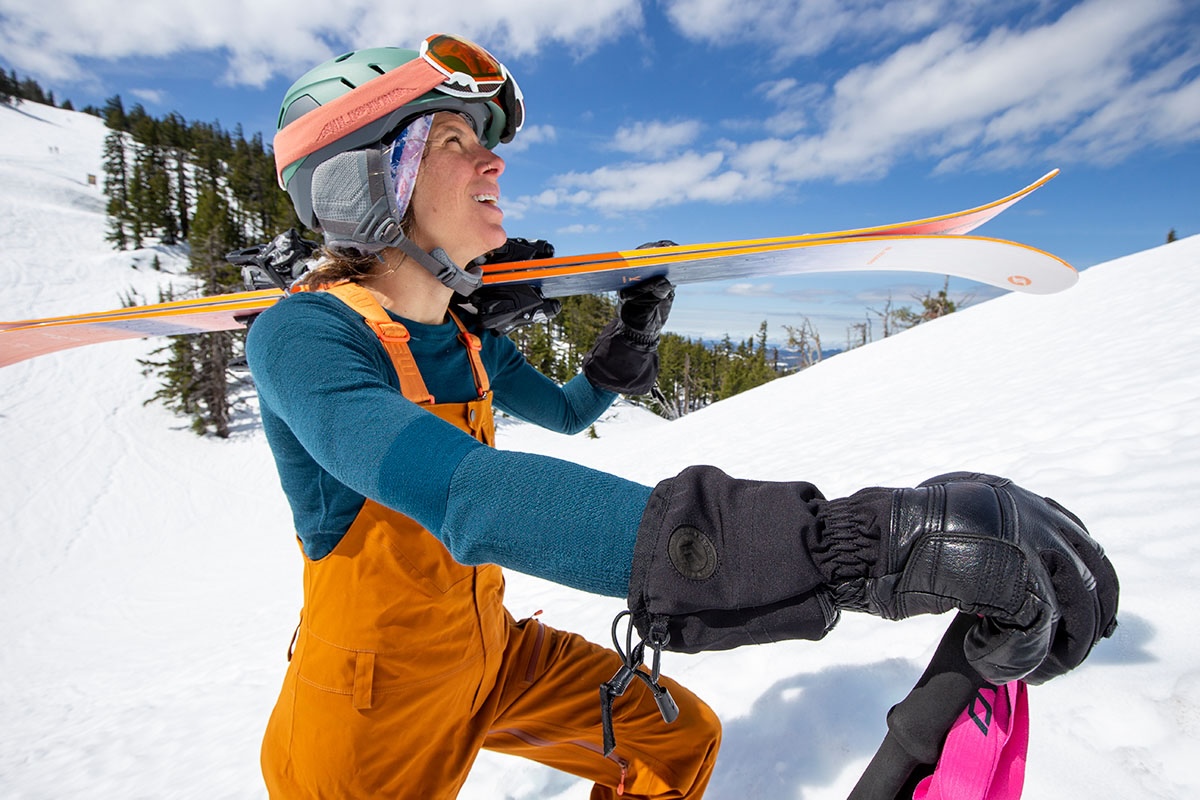
Ski gloves are the classic choice for resort and backcountry skiing and remain the most popular, but mittens can be a viable alternative. In comparing the two, gloves win by a wide margin in dexterity. If you need to grab a lift pass out of your zippered pocket, good luck pulling that off without removing your mittens. It’s also easier and feels far more natural to retain a good grip on a ski pole or adjust your boots or bindings with gloves. But as we touch on in the “warmth” section below, there’s simply no replacement for a heavily insulated mitten. The good news is that many of the offerings above come in both glove and mitten varieties, so you can take your pick depending on weather and personal preference.
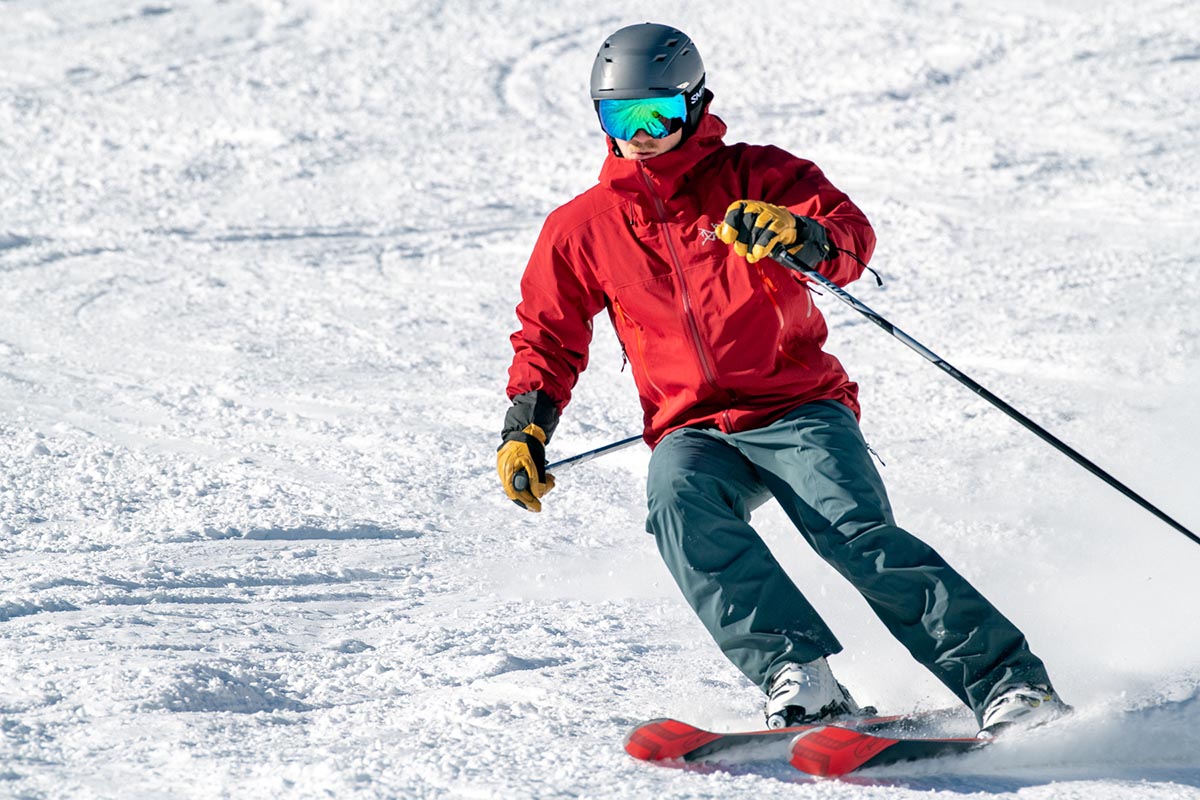
A final alternative is the 3-finger glove (also called a trigger, split-finger, or lobster glove), which brings together the attributes of glove and mitten designs. With this design, the pointer finger and thumb have their own slots while your remaining fingers huddle together for warmth. This style can vary a great deal in the amount of warmth it provides—that lone finger sometimes ends up just as cold as it would be in a standard glove—and we've found that freeing up your pointer finger isn’t a huge difference-maker for dexterity.
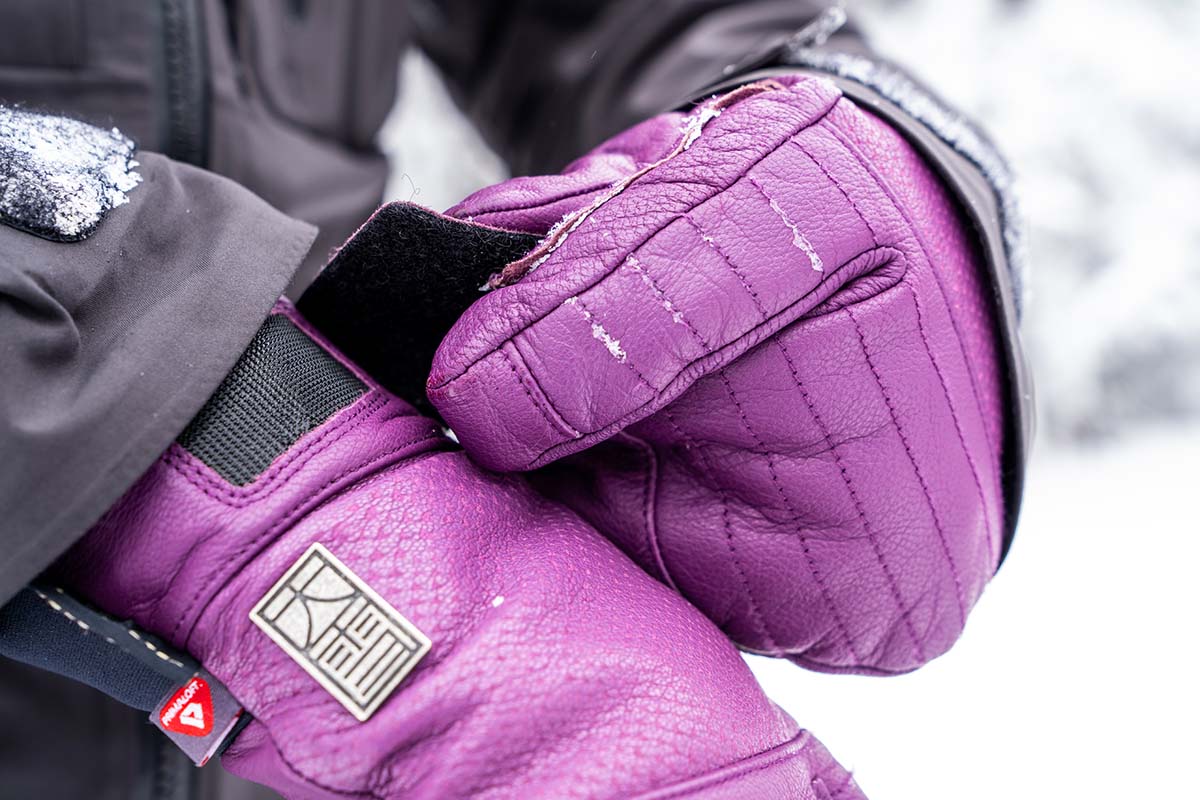
Ski gloves and mittens are constructed with two general material types: synthetic and leather. From a glance at the table above, you’ll notice that many gloves utilize both materials, playing to their respective strengths, so this isn’t always a question of exclusivity. But knowing what each material is best for goes a long way in finding the ideal glove.
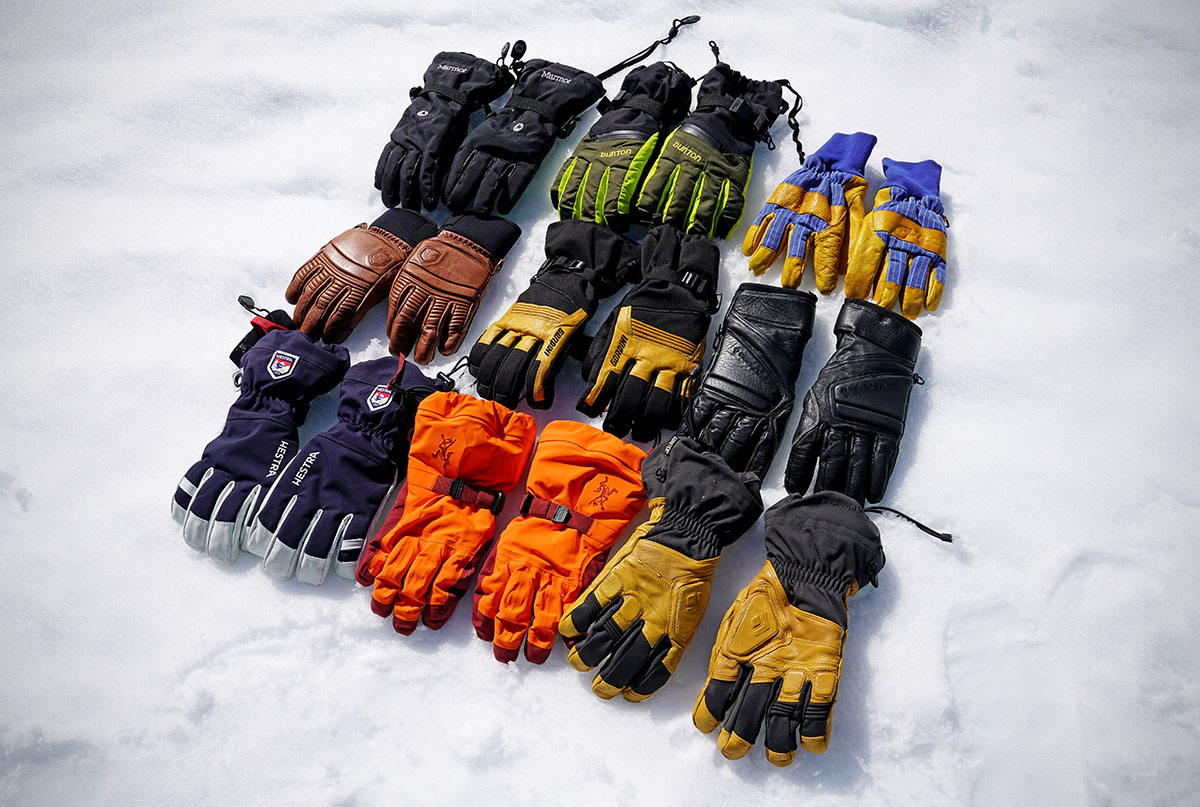
Leather
Leather ski gloves are durable and extremely comfortable, but typically more expensive than synthetics. From premium Hestras to budget options like the Flylow Ridge, they have a much more natural feel right away and are usually more flexible and dexterous than a comparable synthetic. It is way easier to grip ski poles and feel secure with a leather glove or mitten than with a synthetic one. The biggest downside is moisture protection. Leather—and particularly treated leather—is somewhat water resistant and can withstand light to moderate wetness. But eventually they will soak through in wet conditions. To stay dry and extend the lifespan of your leather ski gloves, try Sno-Seal or a Nikwax waterproofing treatment. Most top-end leather gloves have a Gore-Tex or other waterproof layer built in, so while the exterior may dampen, your hands stay dry.

Synthetic (Nylon and Polyester)
Leather has had a resurgence, but many ski gloves still use a synthetic shell. At the mid-range, you’ll find tough but pliant nylon shells that fend off snow, wind, and cold conditions. Cheaper synthetic gloves often use a less flexible polyester shell that doesn’t hold up as well to moisture and can feel bulky. With either type of shell, a waterproof insert is often incorporated between the exterior and insulation. Leather has its advantages, but synthetic gloves usually offer the highest levels of waterproofing. To get the best of both worlds, many synthetic gloves add leather or synthetic leather on the palm and fingers for better grip and dexterity.
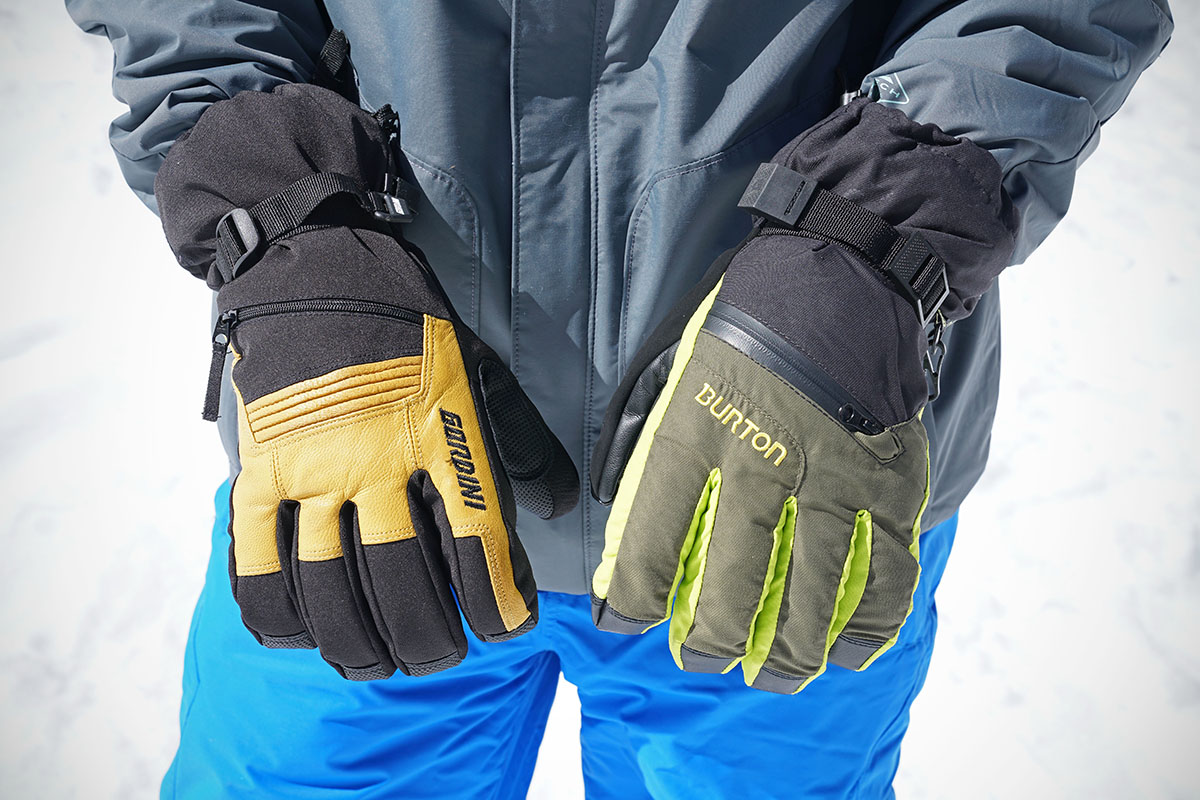
If you’re prone to cold fingers or live in an area with frigid temperatures like the Northeast, you’ve probably found ski glove shopping to be a bit challenging. Most ski gloves under $100 just aren’t warm enough to be comfortable on the chairlift when the temperature dips below about 20 degrees Fahrenheit. In the end, we've found that more expensive gloves like the Black Diamond Guide and Hestra Heli offer the warmth we need. If you have very cold hands and fingers, a heated glove or mitten might be the best call, so that you can keep riding longer. Just keep in mind that the electronics in heated gloves can interfere with avalanche beacons. Conversely, if you run really warm or ski in milder temp conditions, you can save some money with a less insulated glove like the Outdoor Research Arete II or the Flylow Ridge Glove.
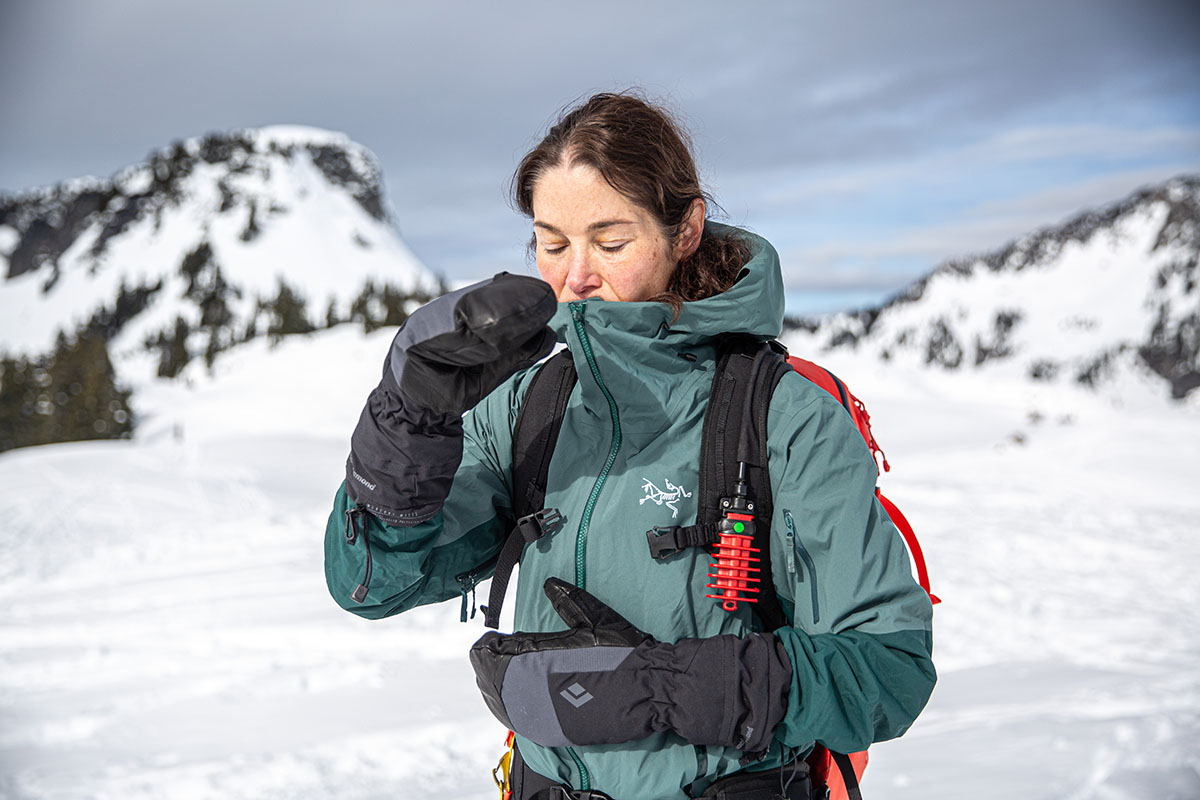
Gloves are insulated in a wide range of ways, from fleece to synthetic fill, so it’s hard to establish exactly how warm a glove will be without trying it on first. Some indications include the weight of the synthetic (listed in grams) as well as the quality. PrimaLoft is the leader for lofty warmth and is popular on many high-end gloves. Some of the warmest designs use a mix of insulation: The Black Diamond Guide has 170-gram PrimaLoft fill as well as plush boiled wool in the lining. For absolute warmth, we turn to mittens instead of gloves, which heat more effectively due toy your fingers pressing against one another. Some skiers may miss the control and dexterity that you get with each finger gripping a ski pole, but it may be worth the trade-off for others.
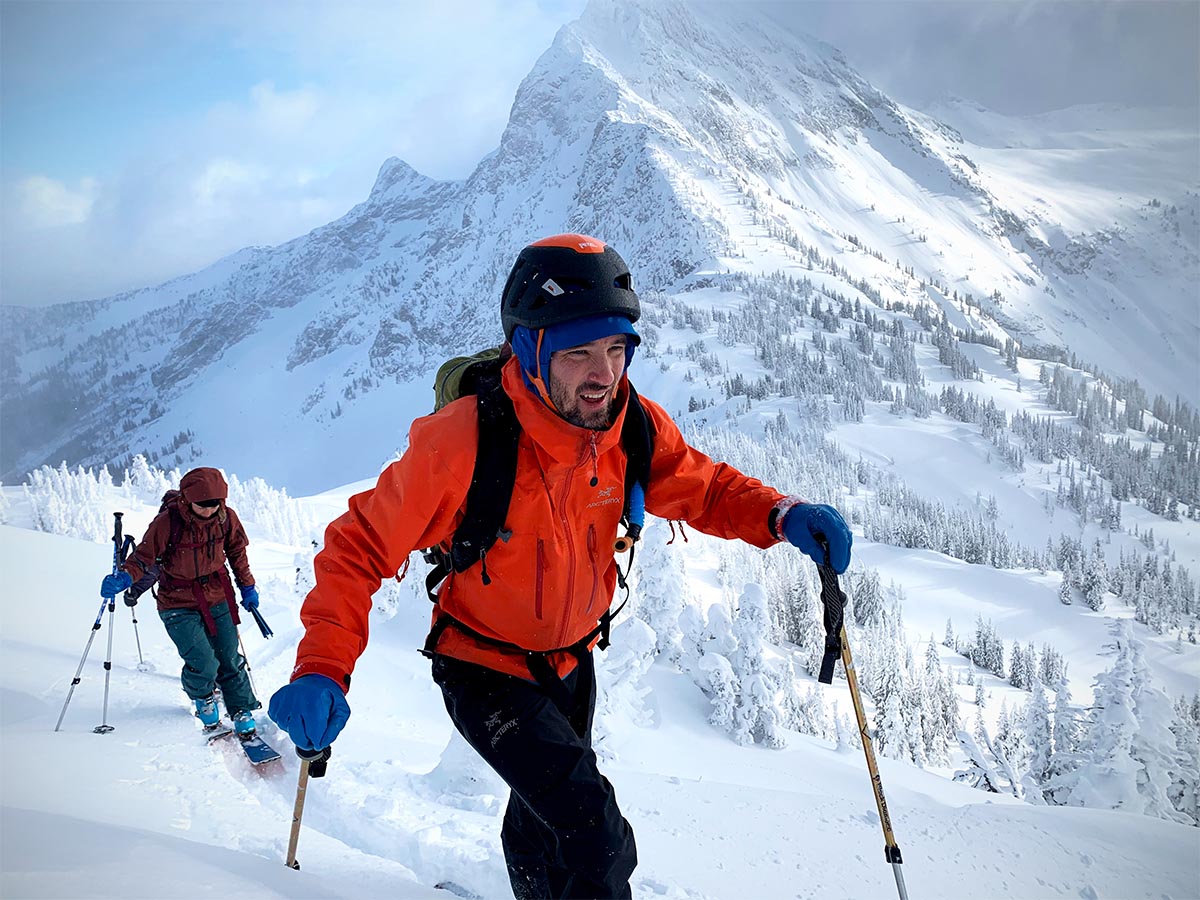
Aside from warmth, waterproofness is the second major factor that can make or break your days on the slopes. And not only does your glove need to keep snow from entering, it needs to let perspiration out from the inside. Located between the shell material and insulation in a fully waterproof design is a membrane or insert. Gore-Tex offers the best combination of waterproofing and breathability on the market. Cheaper gloves often use a non-Gore-Tex insert of varying names (BD.dry, DryVent, etc.) and degrees of efficiency. Keep in mind that if you choose a cheaper ski glove in the $70 range, you can expect decent waterproofing but it likely won't hold up as well over time or on particularly wet days. Entry-level gloves can be fine for those who ski occasional sessions at the resort, but serious skiers will want a serious glove to stay comfortable throughout the day.
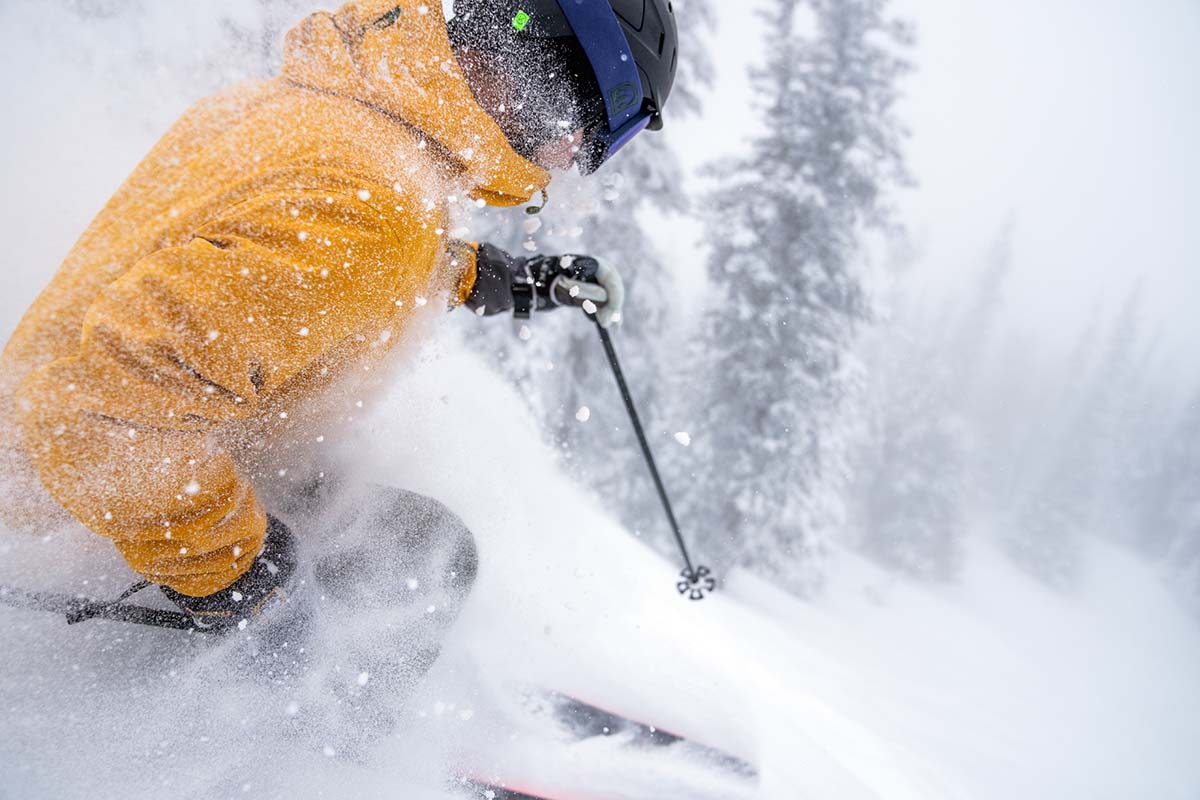
Some gloves forego the Gore-Tex insert and are merely water resistant, which can work in dry climates like Colorado and Utah or if breathability is a priority (one exception is Hestra's Heli, which doesn't include an insert but still has held up well for us in the Pacific Northwest). Usually, the shell has a DWR finish and is treated with a water-resistant coating to shed snow. A non-waterproof design like the Hestra Fall Line can work just fine on clear days, and a well-maintained leather glove can definitely do the trick all season long (for more on this topic, see the care section below). But a fully waterproof design is the safer bet for most weekend warriors.
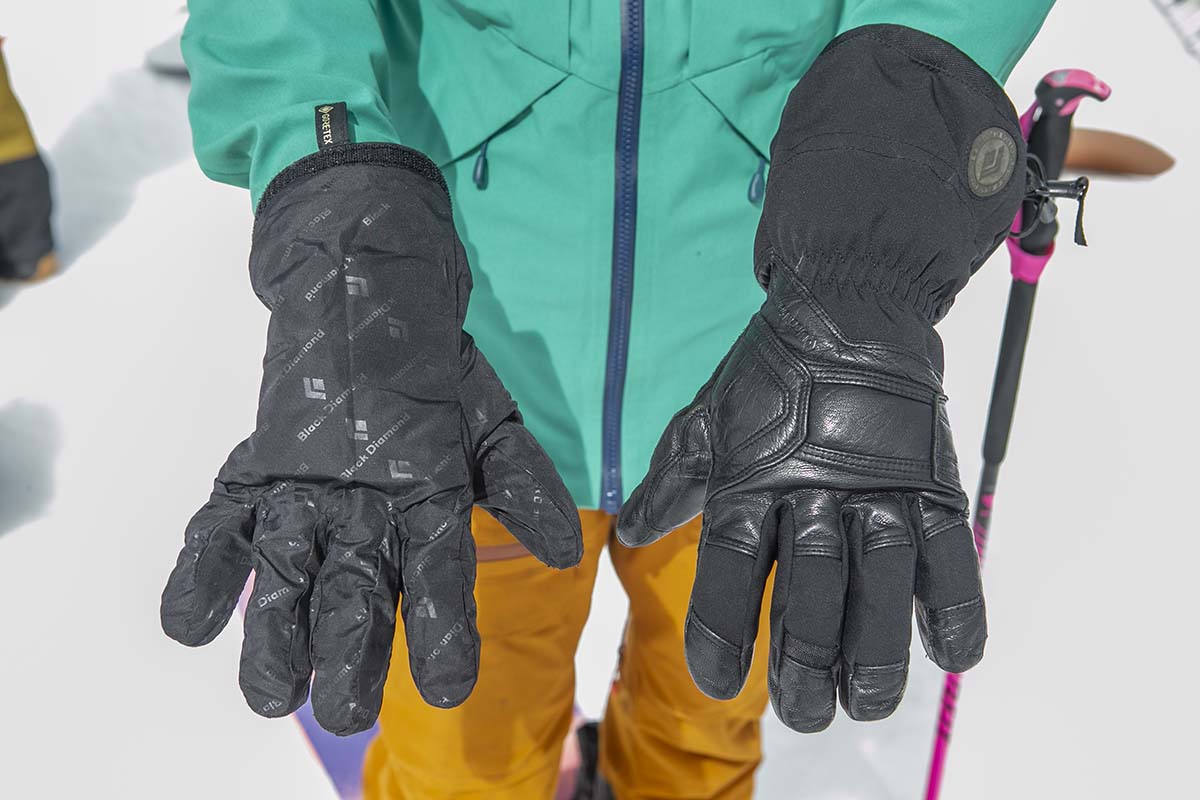
A good number of our favorite ski gloves above include leather in the construction. The natural material is supple and offers excellent dexterity, but it also requires occasional maintenance to avoid absorbing moisture. Most leather gloves come pre-treated, so it’s not something you’ll need to do right away (the Kinco above is one exception). But if you start noticing the material soaking up moisture—also known as “wetting out”—it’s a good indicator that the leather needs some work. Sno-Seal is a beeswax-based solution that is a long-time favorite among skiers. It does require some effort—including baking the glove in an oven—and will darken the leather, but it’s a proven formula that effectively repels moisture. Less involved treatments that still provide good protection include Nikwax’s Waterproofing Wax and Hestra’s Leather Balm. Finally, for gloves with a combination of leather and nylon, we recommend Nikwax’s Glove Proof, which adds a solid water-resistant coating to the outer materials.
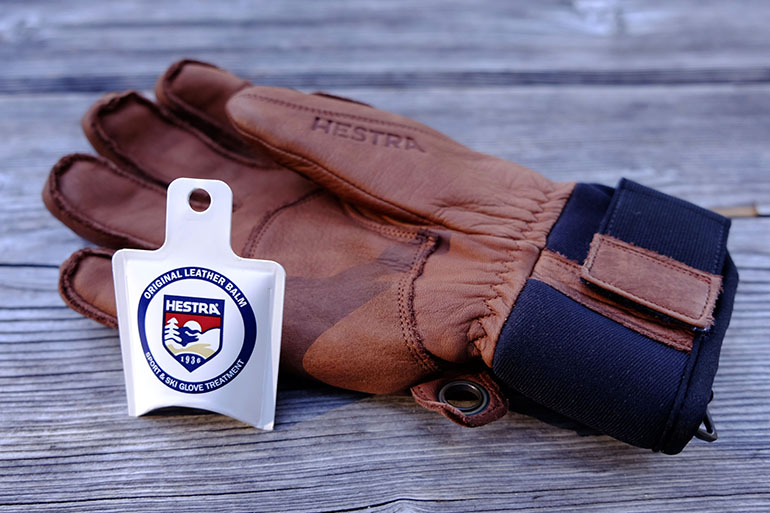
In general, warmth and dexterity go hand in hand. A heavily insulated glove like the Black Diamond Guide is bulkier and harder to use for tasks like unbuckling a ski boot or grabbing your phone. In addition, ease of use correlates with style: Gloves are significantly more dexterous than mittens, and 3-finger mitts split the difference. A final element is the level of R&D—high-end gloves and mitts are better tailored to fit a hand and have a pre-curved shape for a natural feel.
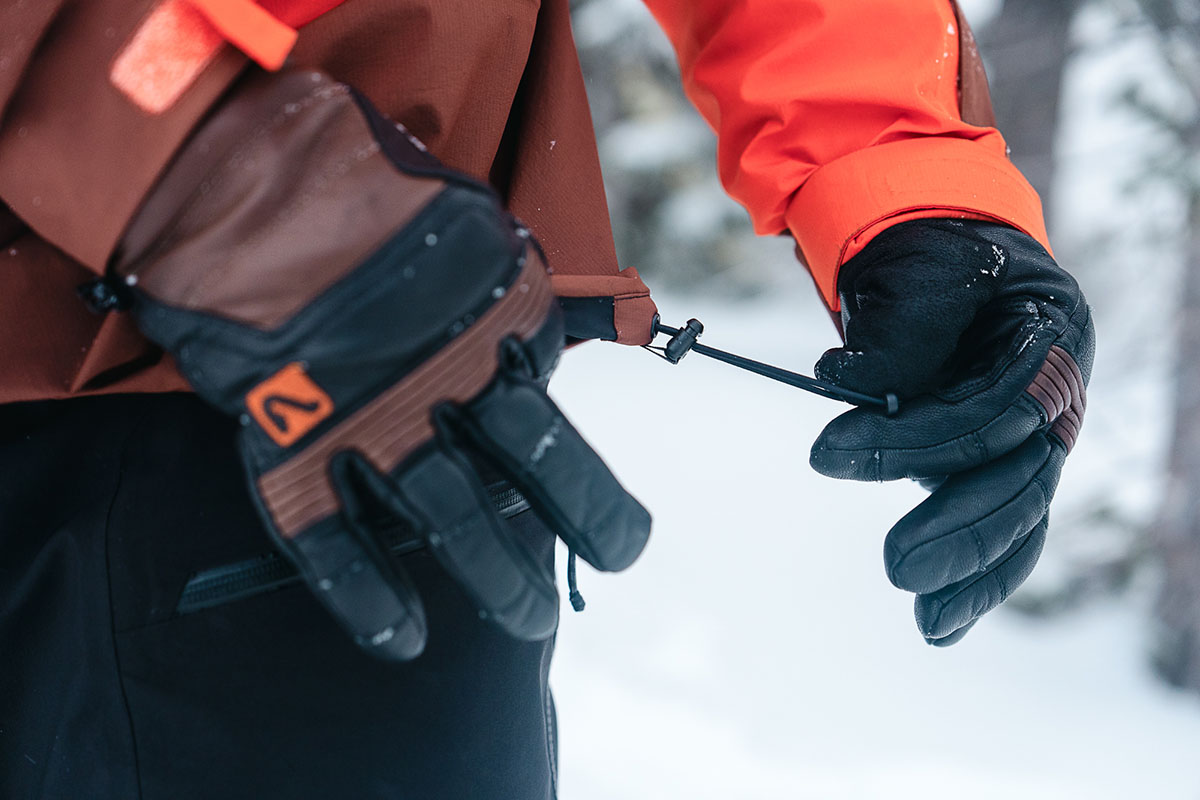
Individual needs will vary, but dexterity shouldn’t be the top consideration for most resort skiers. Even a very thick glove or mitten is serviceable for gripping a ski pole for downhill use (unzipping a pocket and pulling out your phone without removing your gloves is a different story, however). We look for a good mix of freedom of movement without compromising warmth and protection, which is why we find a glove like the Hestra Heli just about perfect. It’s when you ski big mountains, venture off-trail in harsh conditions, or need added dexterity for handling backcountry or ice tools that it becomes worth it to upgrade to an option like the Black Diamond Legend.
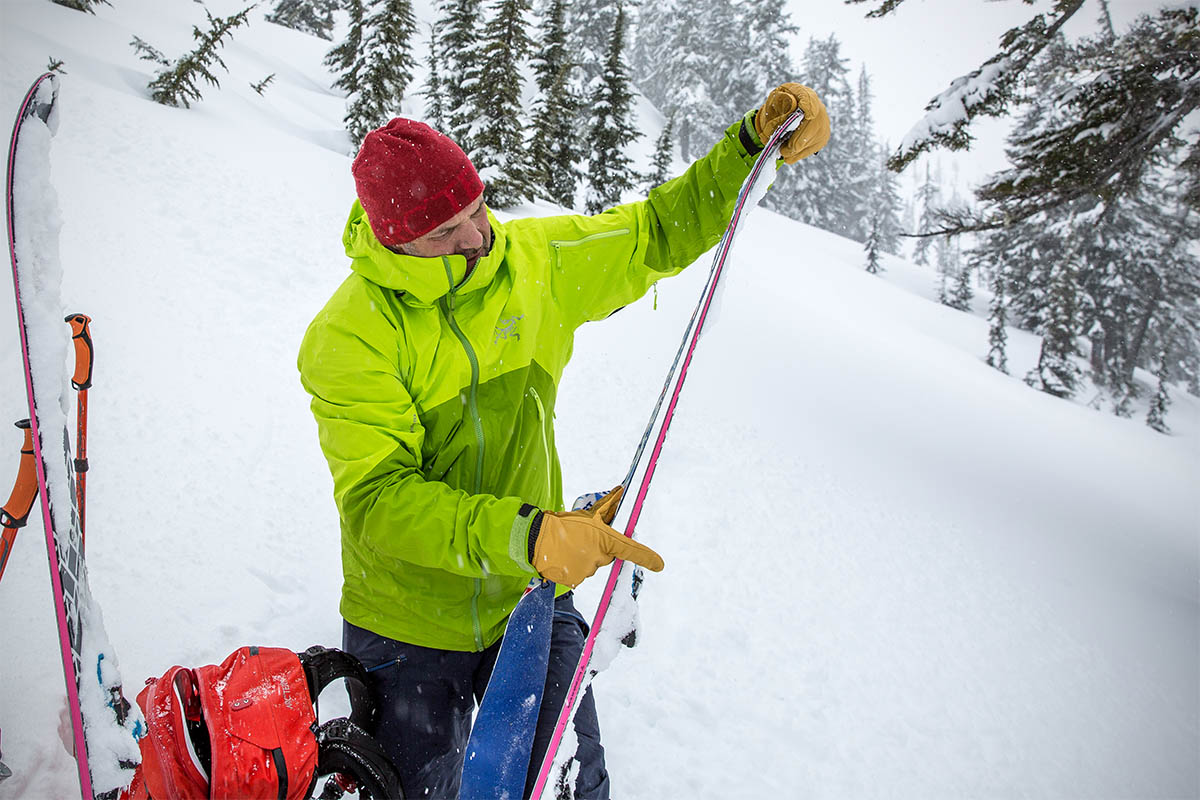
Gauntlet Style
Different skiers prefer different cuff lengths, but there are some concrete concepts that can help make your decision easier. Longer gauntlet-style gloves extend well beyond your wrist, covering the cuff of your ski jacket. This style is generally warmer because they have more insulation and seal out the cold very effectively with a drawcord. This also means less range of movement in your wrist with more material in the way. Shorter gauntlet-style gloves that barely cover the cuffs on a jacket leave a pathway for moisture to enter in really wet conditions (more on wrist cinches in our features section), but this style is also the easiest to get on and off.
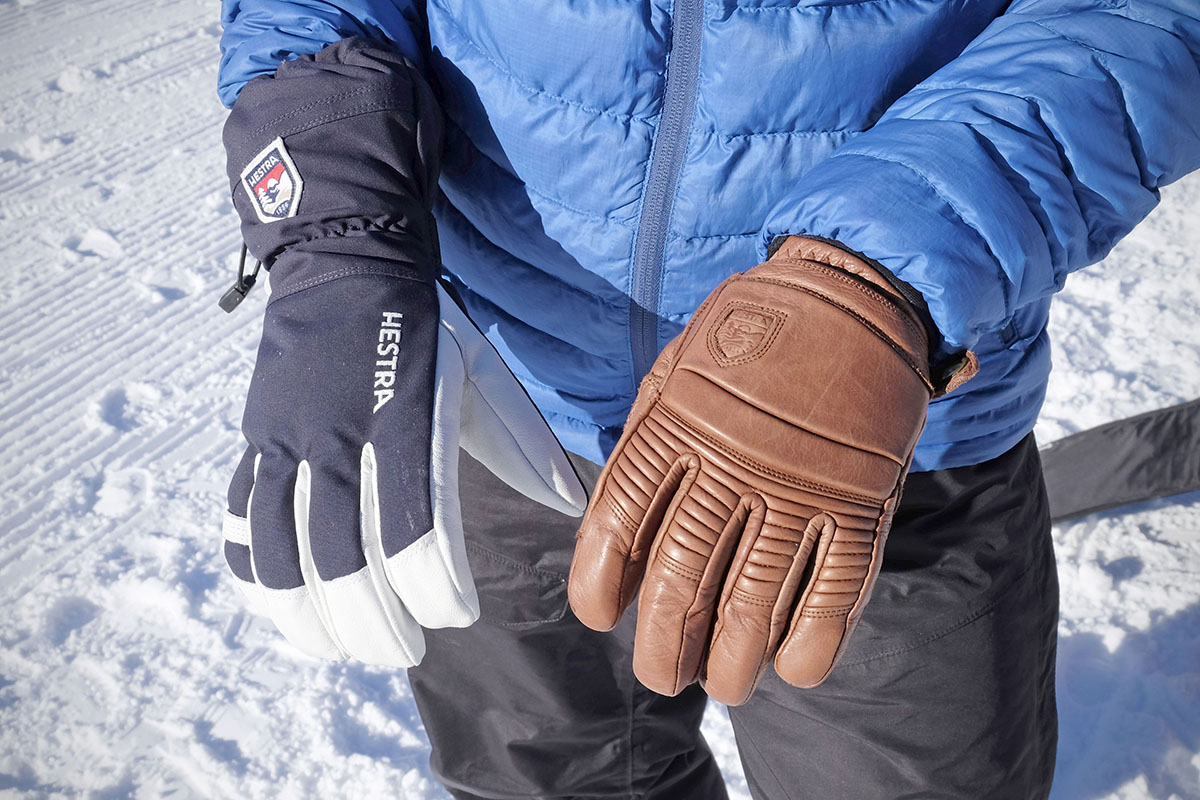
Undercuff
Shorter undercuff gloves tuck into your ski jacket, which requires more work than simply sliding on a gauntlet glove, and they don’t provide quite as much warmth. Also, if your sleeves ride up when you’re reaching forward, say to plant a ski pole, you can expose some skin. On the other hand, they offer more agility with less bulk getting in the way of wrist movement and are easier to ventilate. Many of Hestra's gloves in their Freeride line are undercuff, and some backcountry skiers prefer the freedom you get with this style. On the flip side, gauntlets are popular for maximum protection in deep powder and cold weather (or wet) resort days.
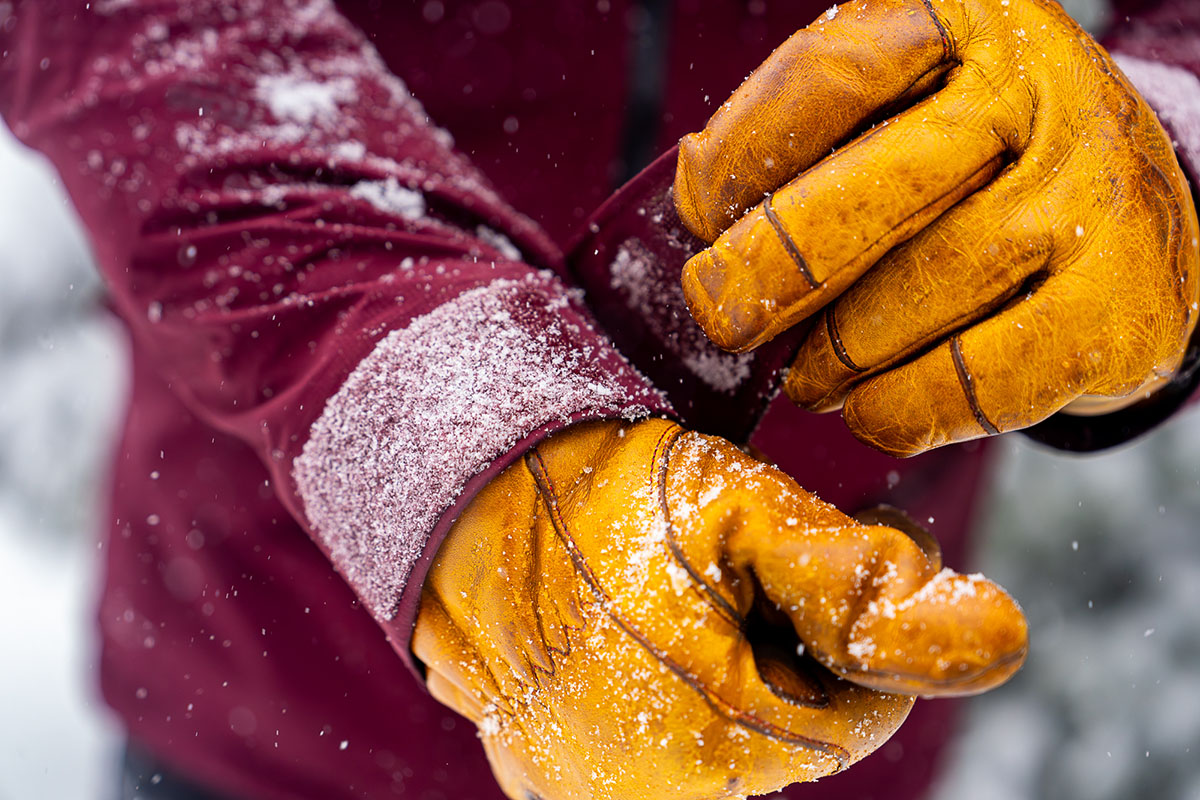
Across all price ranges, you’ll have the choice between gloves that are made with or without removable liners. In general, gloves with removable liners will be slightly warmer but are a little bulkier and less dexterous. For us, the most compelling reason to choose a glove with a liner is that it’s more adaptable to different temperatures. You can wear the shell on a warm spring day and use both (or swap out other liners you may own) for the rest of the season. Another benefit is that it’s easier to dry out the gloves if they happen to get wet by separating the two pieces. And as a bonus, if you get a glove with thin liners (like the Dakine Titan), you can use them for activities like cold-weather running or driving.
.jpg)
A proper-fitting glove helps maximize everything from warmth to dexterity, so it’s worth the time to nail down your ideal size. And while the market isn’t consistent with how they list glove and mitten sizing—you’ll see standard small, medium, and large options as well as numbers-based sizing from a brand like Hestra—the good news is that most rely on a simple hand circumference measurement. To get your size, wrap a soft tape measure around the widest point of your hand (typically right behind the knuckles) and match it to the manufacturer’s corresponding range. If you wind up in between sizes, it’s best to go up to avoid pinch points or an overly tight fit (which compromises both comfort and warmth).
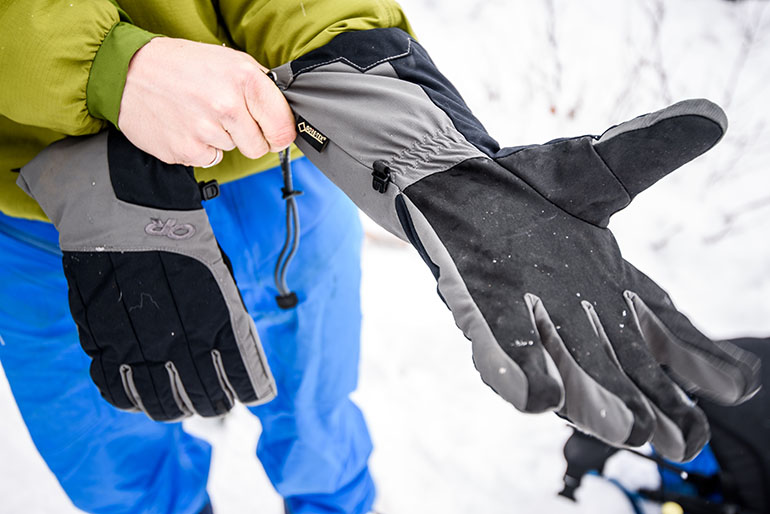
It’s worth noting that relying on your hand circumference isn’t a foolproof process, as the sizing doesn’t account for finger length, so it’s always ideal to try gloves on before purchasing. But if you need to buy online or just prefer the convenience, following the manufacturer-specific fit guidelines (avoid generic charts) and buying from a reputable ski retailer with a good return policy is a smart way to go.
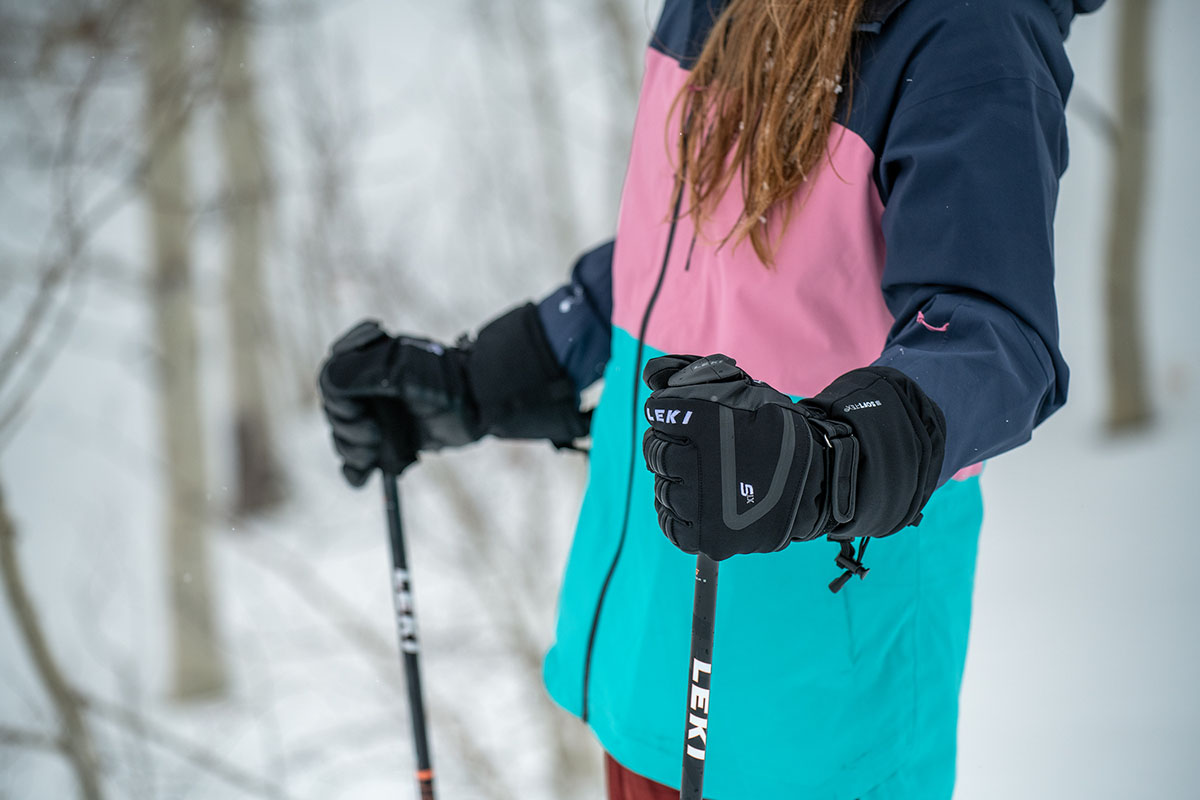
Touch-Screen Compatibility
Why wouldn't you want touch-screen sensitivity on your ski gloves? A number of manufacturers now offer exactly this so that you can snap photos or videos without taking your gloves off. You'll most often find the technology, on thin gloves and liners where it's easier to incorporate, plus the thinner liners are more precise when typing. On some models, only pointer fingers and thumbs are touch-screen compatible. Overall, we consider this a nice feature if a model you like has it, but it's not the first factor we consider in selecting a glove.
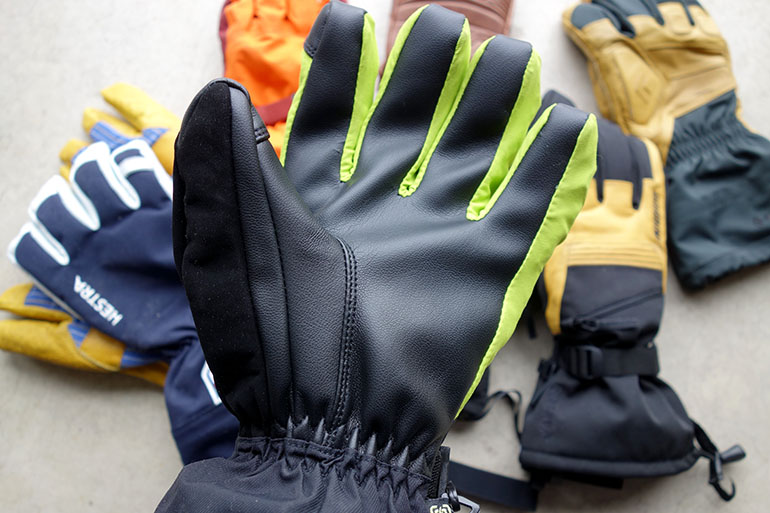
Wrist Cinches
Gauntlet-style gloves in particular often have a cinch or draw cord to tighten the opening where snow can enter (this differs from a wrist strap, which tightens the glove over the hand and wrist). By pulling the cinch or draw cord, you can effectively prevent moisture from entering your glove in all but the wettest of conditions. Much like a powder skirt on a ski jacket, this can be very effective at tightening down your gear before skiing through the deep stuff.
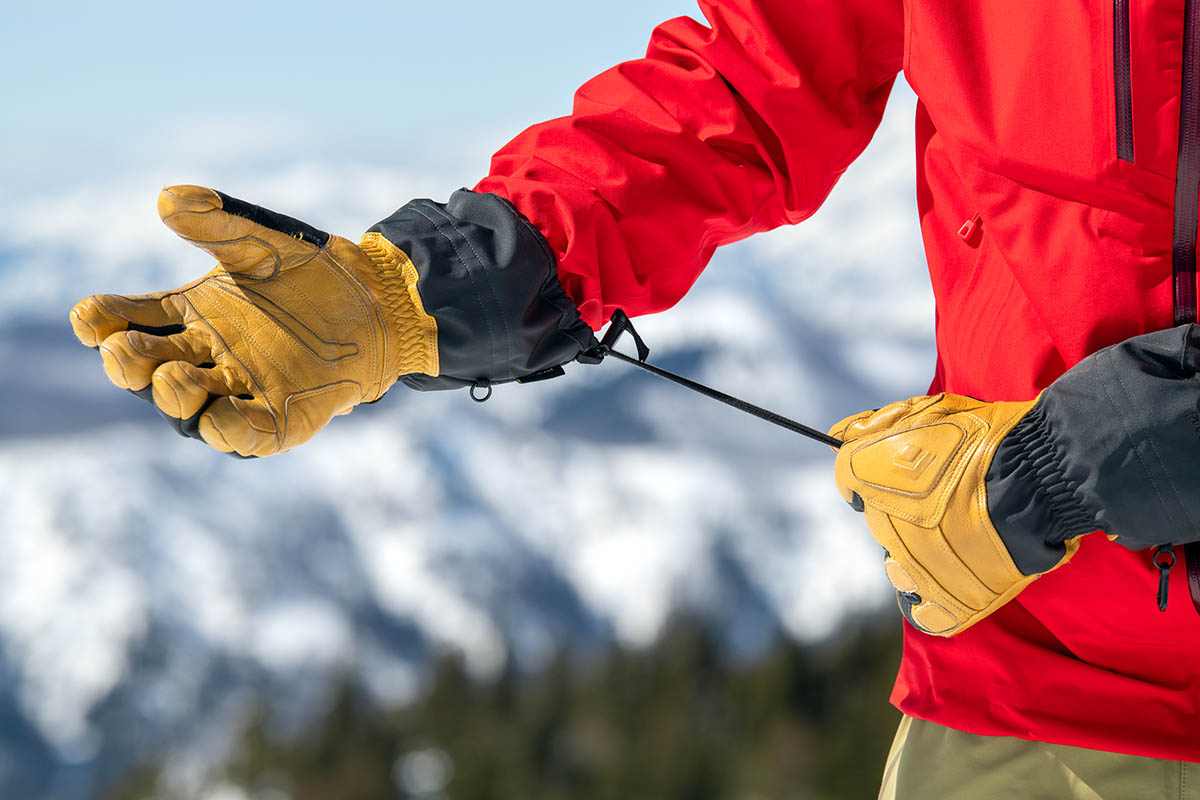
Wrist Leashes
Wrist leashes—also known as keeper cords or retention straps—are a fairly common feature among resort models as a way to keep you and your gloves together should you take a serious fall. The design is simple: you slide your wrists through the adjustable cuffs (they can be as minimalist as a piece of string), and a strap connects you to the gloves. The main advantage is not leaving them behind if you take a tumble, but the straps also provide security if you remove your gloves while riding the chairlift. It’s certainly not a necessary feature, and some don’t like the extra bulk, but most skiers find the trade-off worth it for the added peace of mind on the slopes. From our picks above, wrist leashes are included on gauntlet-length designs like the Hestra Heli, Black Diamond Guide, and Gordini GTX Storm.
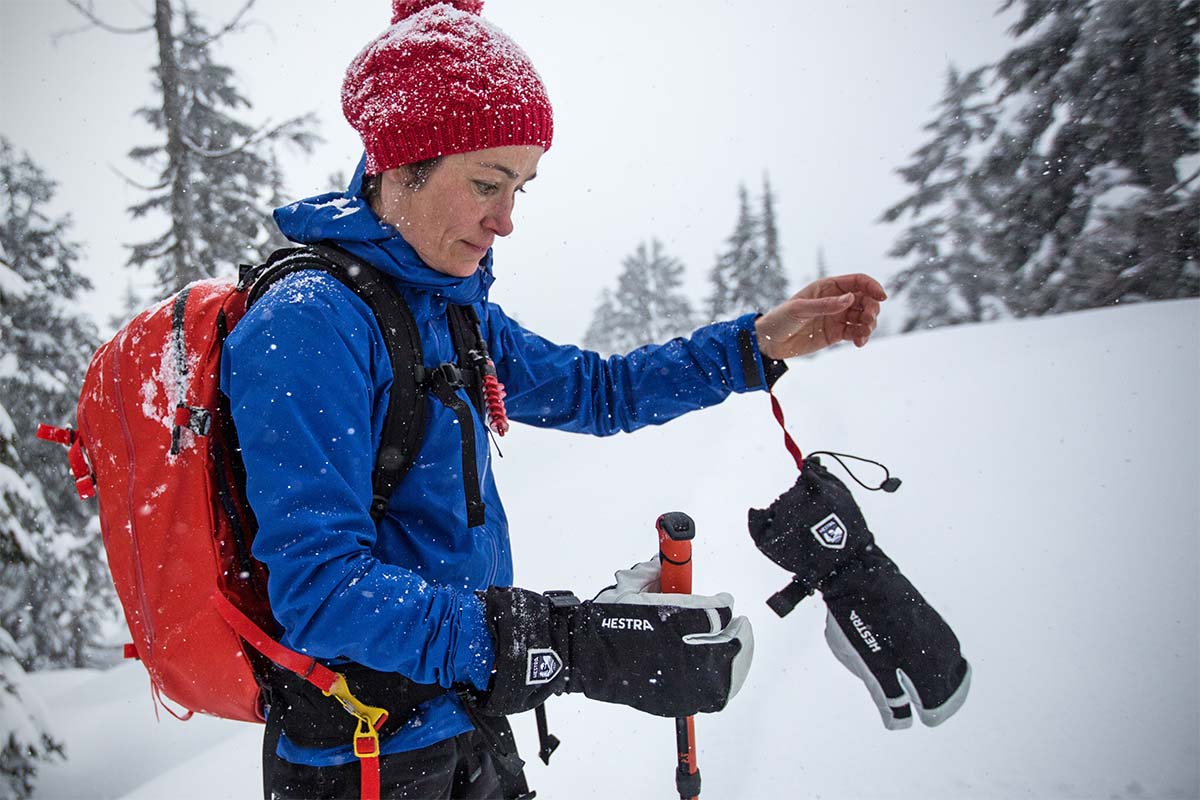
Nose Wipes
It's not easy to grab a tissue with your gloves on, so many models feature a soft patch of fabric on the thumb or pointer finger to help with your runny nose. Nose wipes are good in a pinch and the fabric helps to avoid irritation that you might get from doing the same thing with the tough shell fabric of your jacket. Of course, they lose their effectiveness when overused or when the temperature really drops, but they are a nice touch nevertheless.
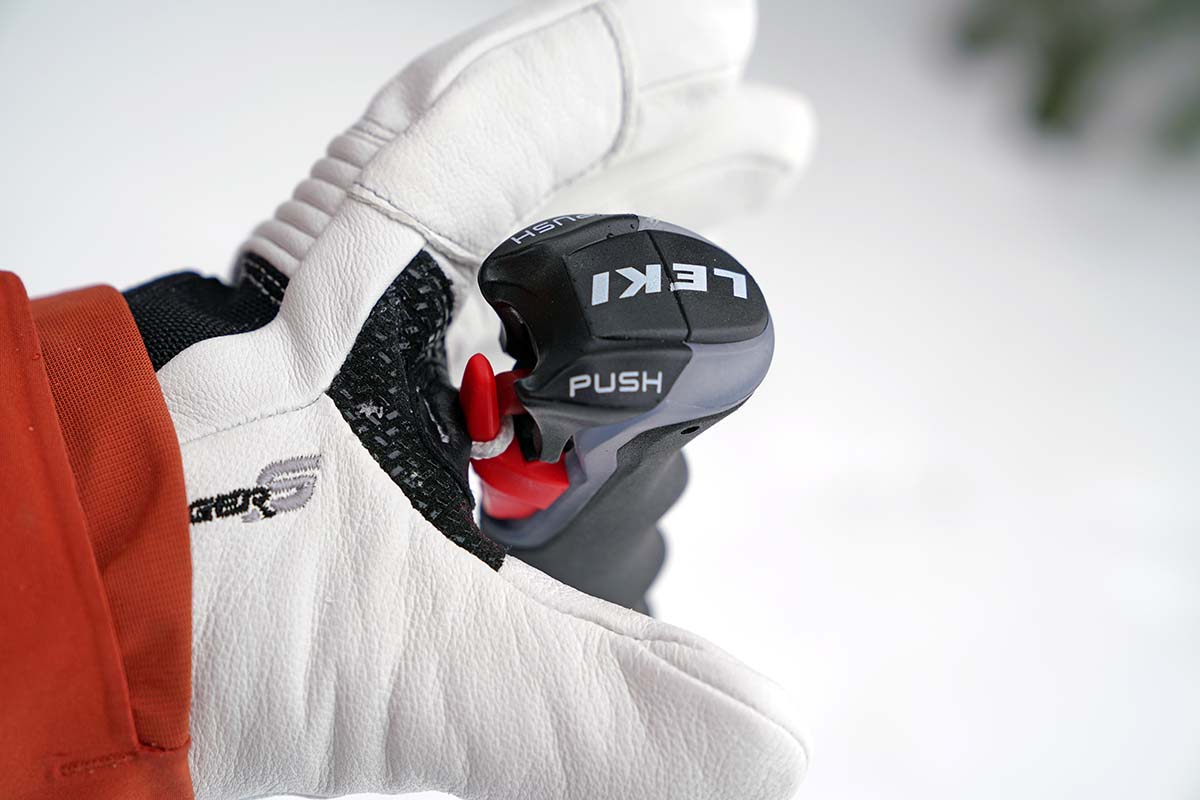
Leki’s Trigger System
Typically, skiers will secure their poles to their hands using wrist straps—an age-old system that few innovations have challenged. But it’s not foolproof and can be especially hazardous in the event of a fall (many skiers—especially backcountry skiers—don’t use their straps because of this). Seen on the Copper S above, Leki’s Trigger System offers a really intriguing alternative, pairing a small fabric loop on the glove with a click-in-click-out hook on compatible poles. The hook eliminates the extra bulk and hassle of a strap, is super slick in practice (clicking in and out of it quickly becomes second nature), and releases either with the touch of a button or when the glove’s loop reaches a specific angle (220˚). Not every skier will be interested in such a high-tech system, but it certainly has its appeal. And the good news is that Leki offers a near complete range of gloves and poles, so you don’t have to compromise on warmth or performance.
Back to Our Top Ski Glove Picks Back to Our Ski Glove Comparison Table